The iDeaL Approach for Specialists in a School Setting
This series of snippets shows what using the iDeaL Approach for Specialists can look like in a school context – where routines, session lengths, and support structures may differ. Through these sessions, we’re learning what works: adapting lesson length, incorporating modelling books, building in more review, and using student insight to shape what comes next. And we're sharing the journey with you as we go.
Contents
Exploring the iDeaL Approach for Specialists in a School Setting
Hugo is 9 years old and is in Year 5. He’s curious, eager to learn, and the focus of a new journey we’re sharing as we explore how the iDeaL Approach for Specialists can be adapted and delivered in a school-based intervention setting.
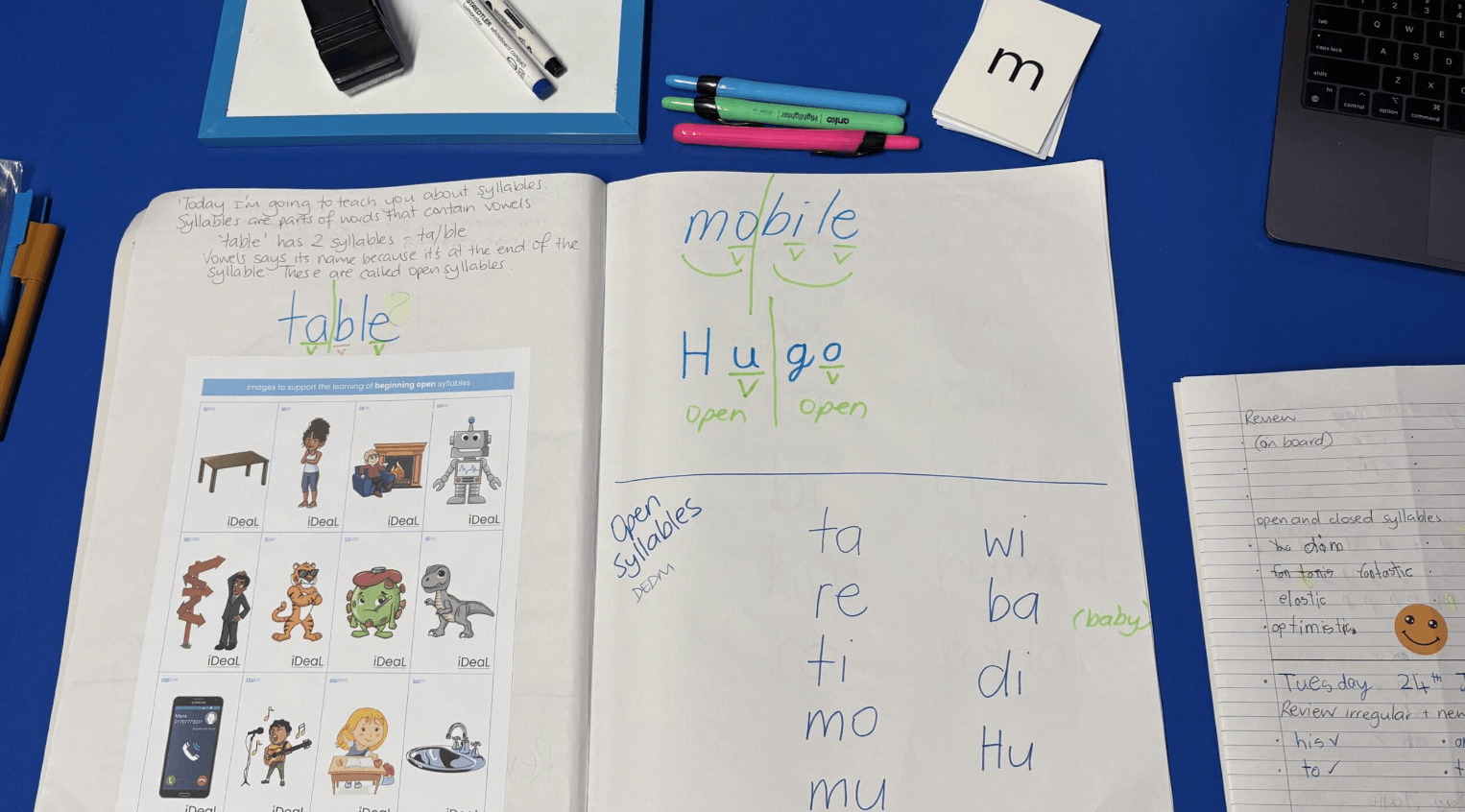
Background
Hugo’s school has had a school-wide Structured Literacy approach in place for the past three years. He previously received support through an external agency, but this was discontinued after it was determined he had made sufficient progress. However, his principal remained concerned and put Hugo’s name forward for further assessment, recognising that, despite gains, there were still additional needs to be addressed.
That’s where this journey began
Ange, one of our team members, completed the Mini Literacy Assessment with Hugo and began working with him using the iDeaL Approach for Specialists. This has given us a valuable opportunity to explore how these specialist resources, originally developed for 50–60 minute lessons in a private tutoring setting, can be adapted for use in schools, where sessions may be shorter and shaped by timetable constraints. In Hugo’s case, all sessions with Ange are 30 minutes long and occur twice per week – providing a consistent structure as we observe and reflect on his learning journey.
Assessment Results
Results from the Mini Literacy Assessment indicate that Hugo has a secure understanding of basic consonant and vowel sounds, as well as strengths in rhyme identification and syllable blending. A personalised, multisensory, cumulative and structured intervention will enable him to strengthen his phonological awareness and deepen his understanding of how letters and letter combinations represent sounds. A key focus will be on enhancing his ability to generate rhymes and manipulate phonemes – including beginning sounds, end sounds, and blends. Hugo also requires explicit instruction in all syllable types and spelling rules, which will improve his accuracy and help reduce the cognitive load that currently affects his writing.
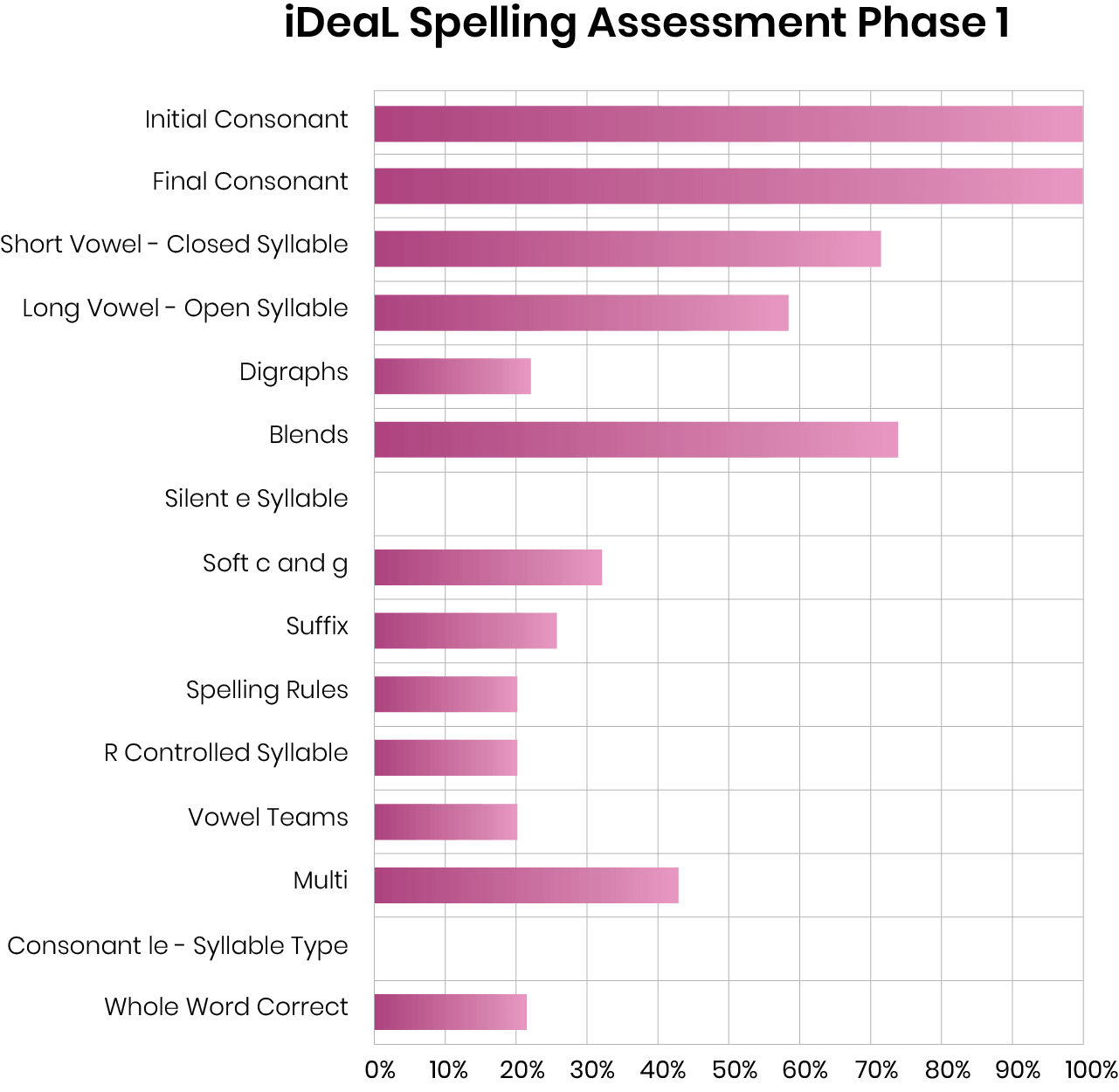
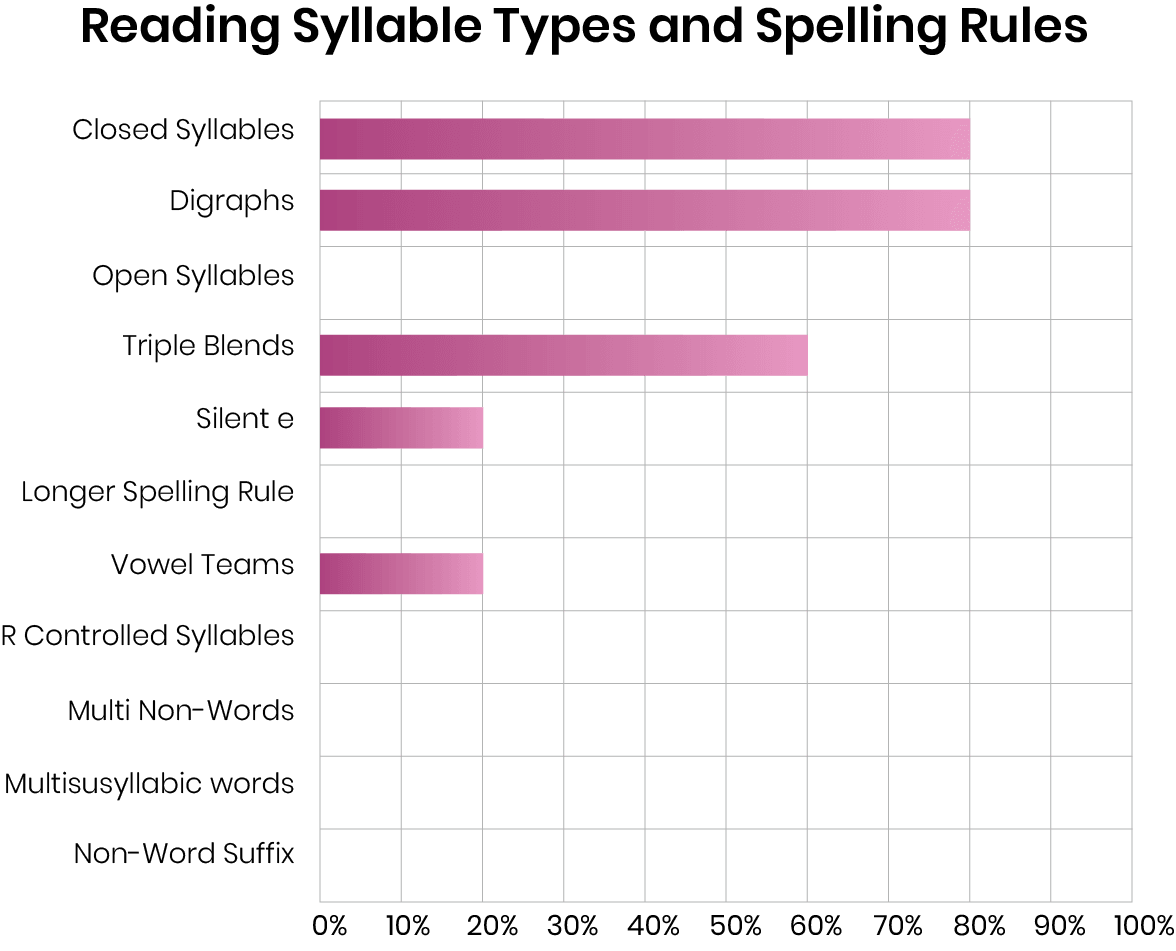
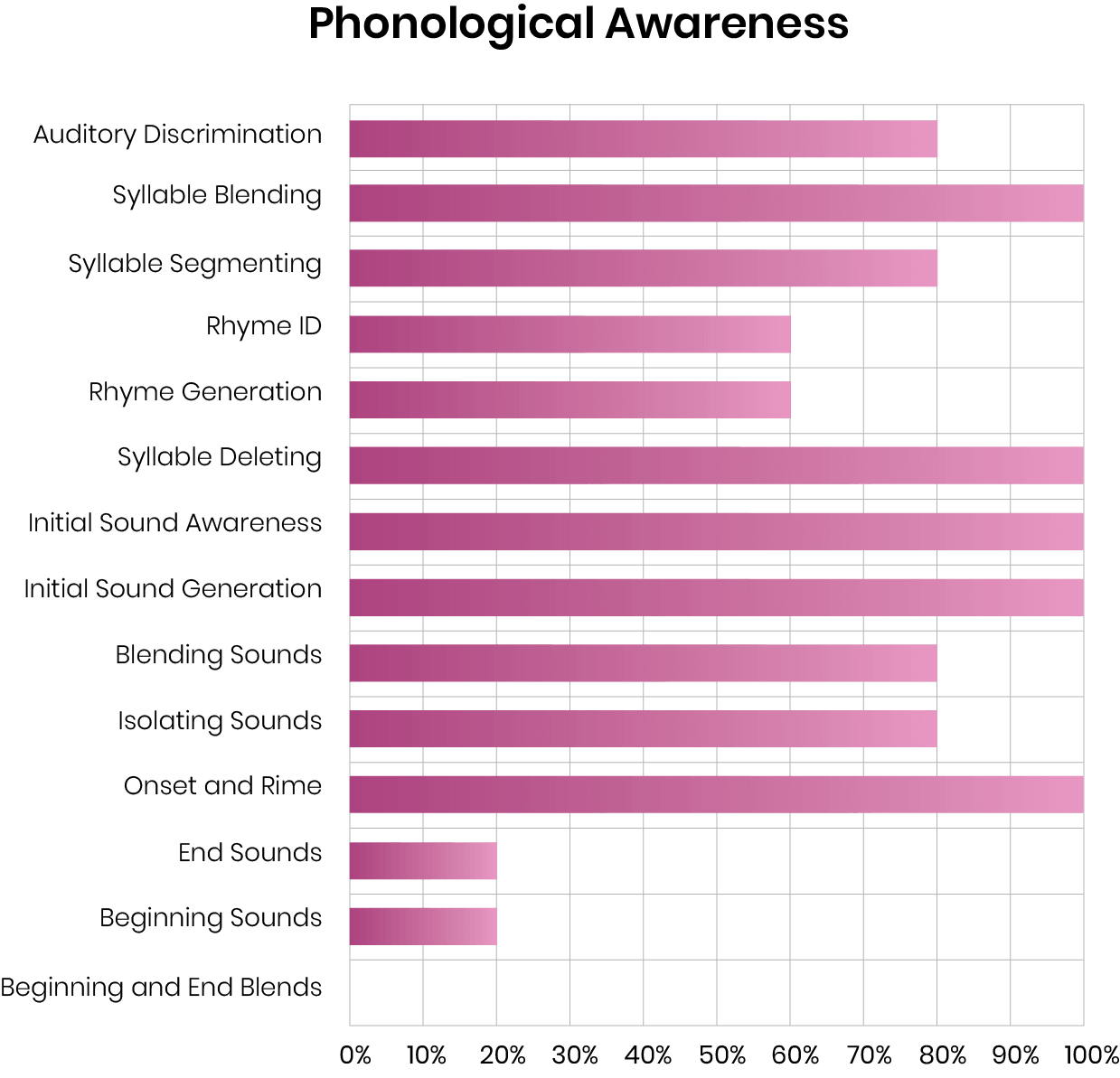
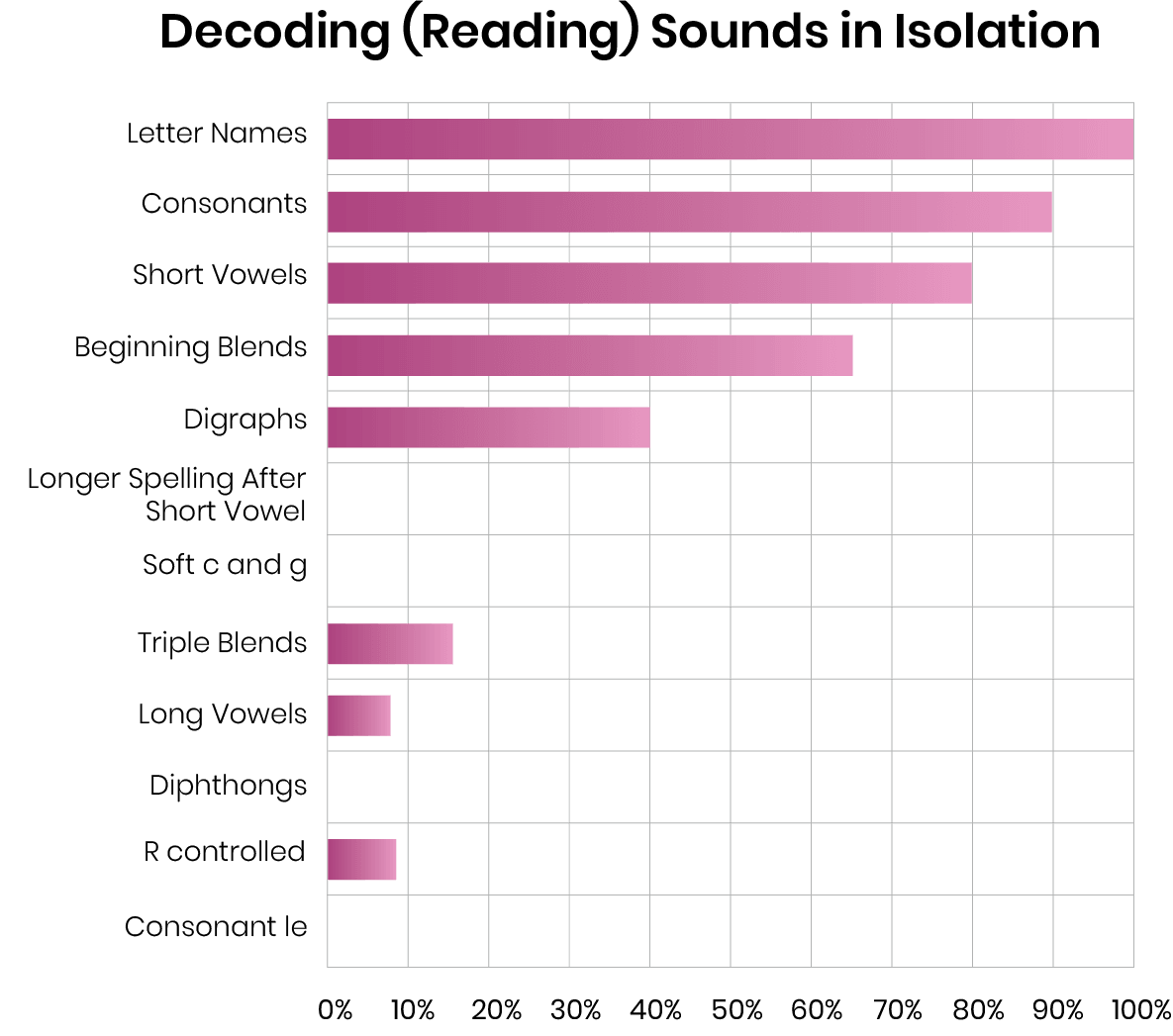
Why We’re Sharing This?
This journey is about more than just one student. It’s an opportunity to show what using the iDeaL Approach for Specialists can look like in a school context – where routines, session lengths, and support structures may differ.
We’re learning what works: adapting lesson length, incorporating modelling books, building in more review, and using student insight to shape what comes next.
Routines and Discoveries
Session 1 focused on setting up routines – introducing the lesson structure, where to write, how to highlight, and how marking would work. With so much to establish, time was tight, but Hugo’s enthusiasm was obvious from the outset.
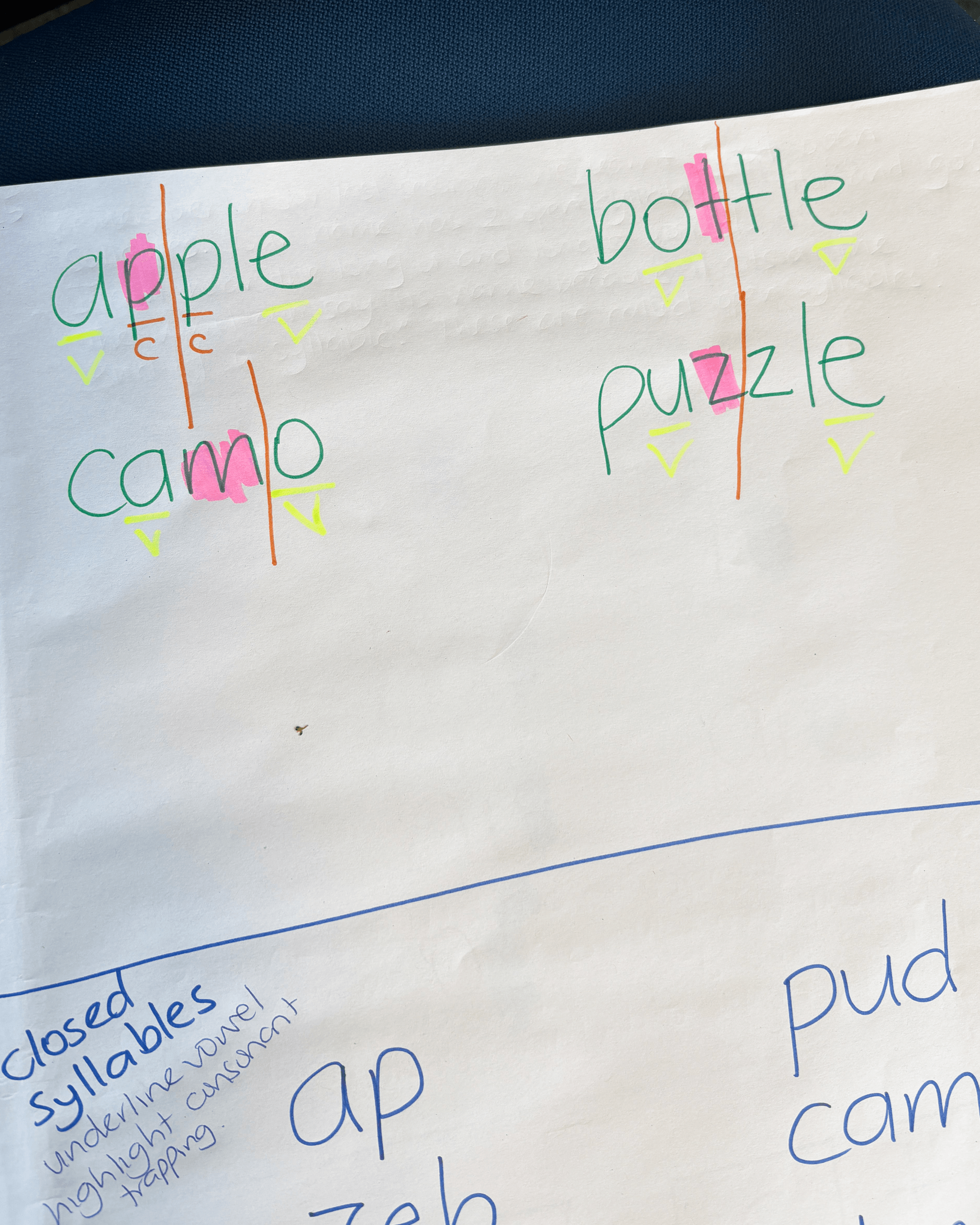
By Session 2, Hugo was already making discoveries. While highlighting the consonant after the short vowel in a closed syllable word list, he paused and said, “Hey, there are a, e, i, o, u in every word here!” A great opportunity to talk about vowels and syllables – one of those authentic moments of learning you can’t plan for but can build from.
When planning Sessions 3 and 4, Ange realised a fifth session would be needed to tie together open and closed syllables. More review, more exposure – key to retention. This reflects one of the most important principles of explicit instruction: frequent and purposeful practice.
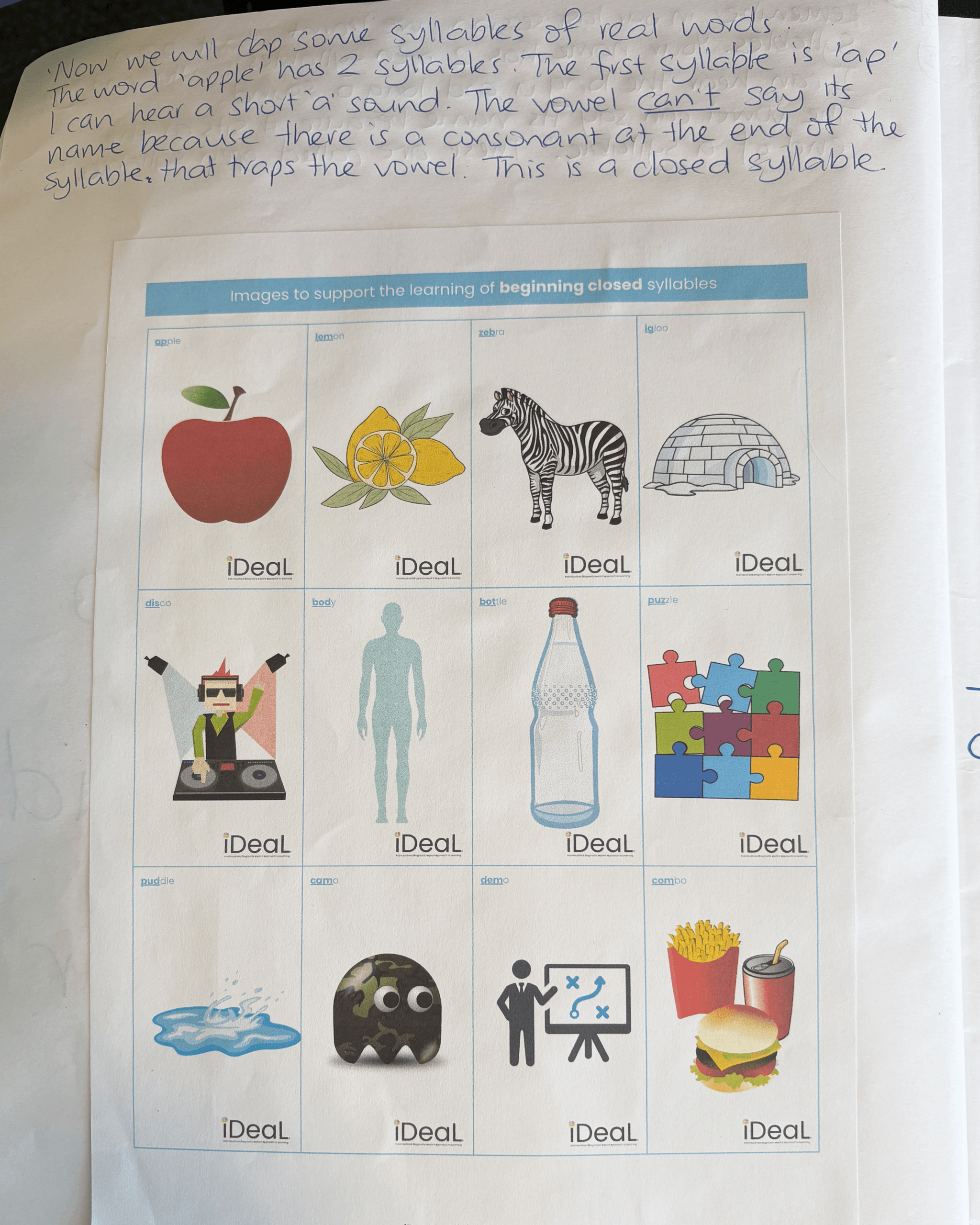
We’ll continue sharing Hugo’s story as it unfolds – highlighting what’s possible when evidence-based teaching meets personal, responsive instruction.
Syllable Division in Action
By Session 3, Hugo’s teacher had already noticed a boost in his confidence with reading. His accuracy with open syllables had improved and he was decoding more fluently. When tired, Hugo would sometimes revert to short vowel sounds – reinforcing the need for regular, spaced review.
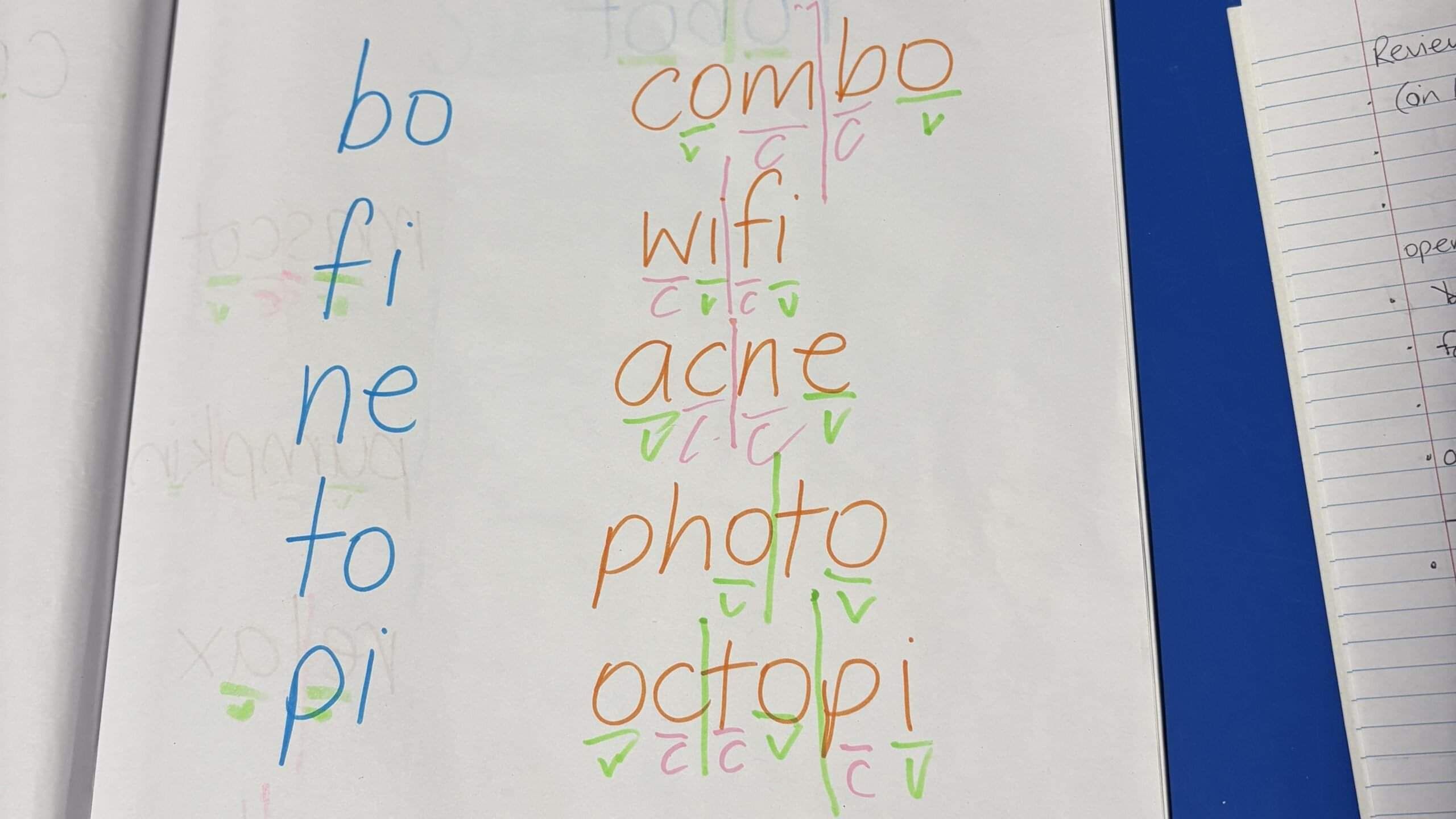
Session 4 was a real turning point. Hugo was engaged, confident, and applying his learning. He was able to distinguish between open and closed syllables and successfully read unfamiliar words like mascot and vortex using syllable division strategies.
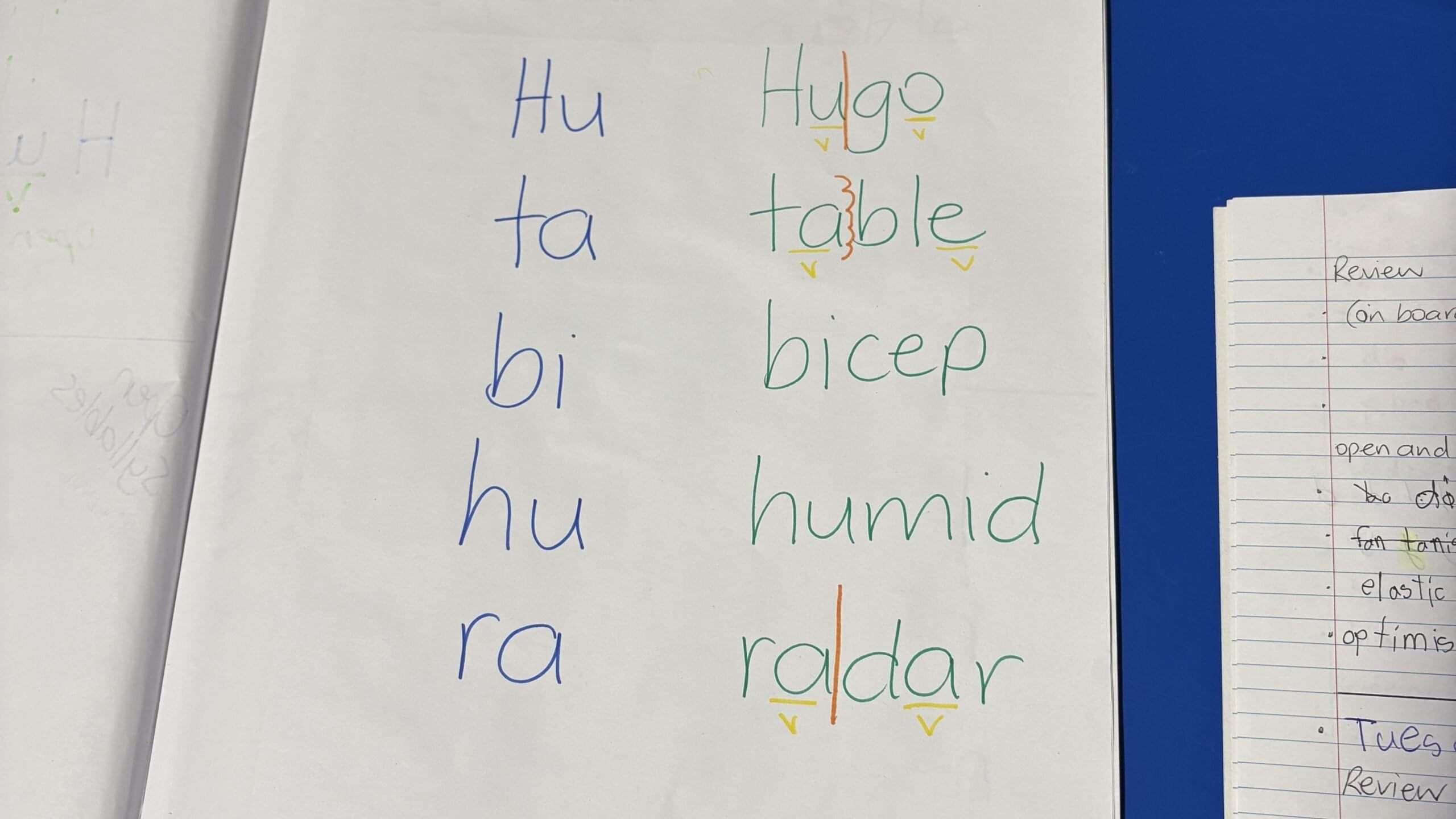
In Session 5, the focus was applying this knowledge to spelling multisyllabic words like fantastic, volcano, and elastic. Hugo was proud of his success – working one syllable at a time, using sounds to guide spelling. Ange noted he sometimes used letter names rather than sounds, so regular practice of the sounds during the letter formation section of the lesson will help to address this.
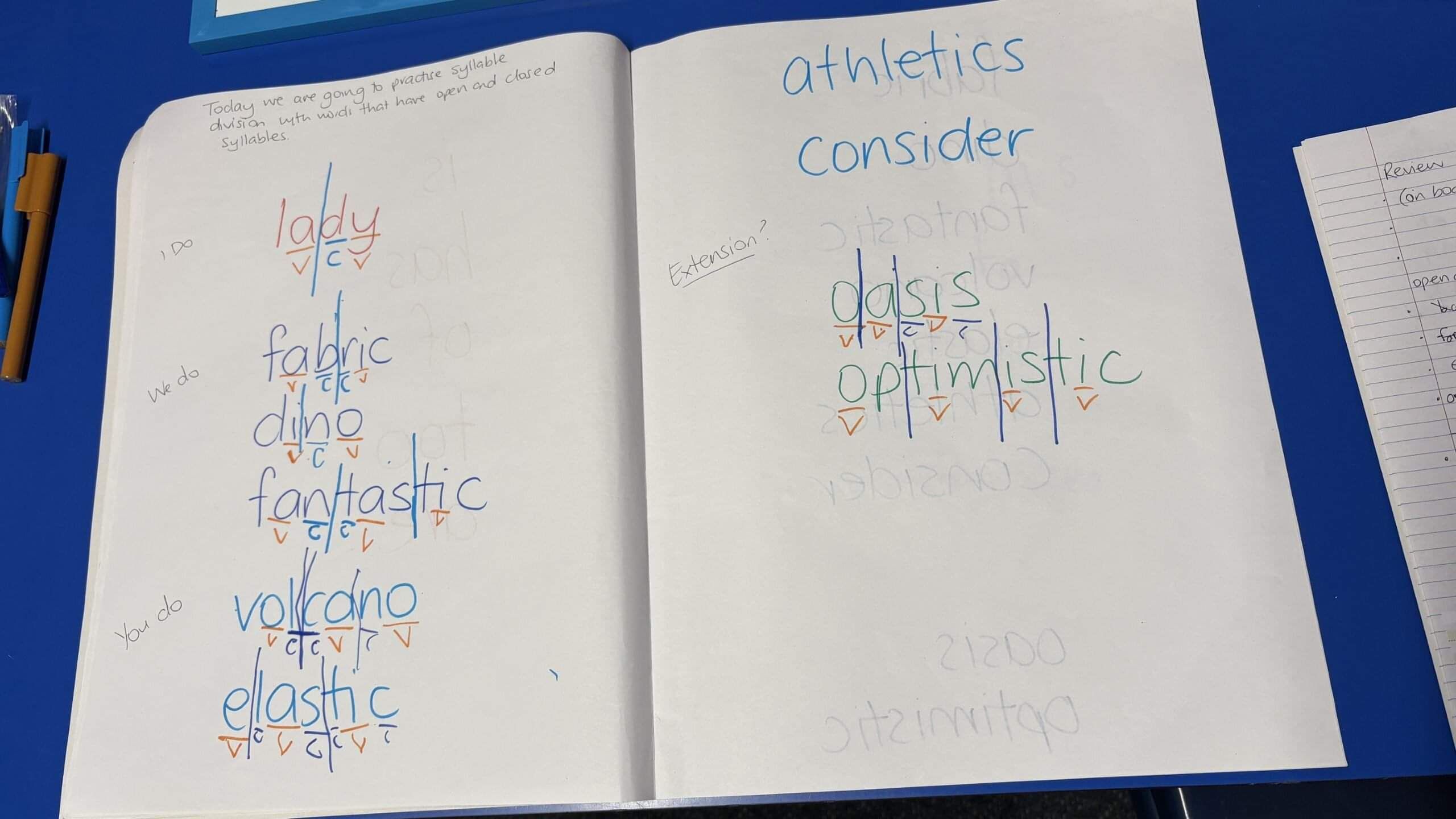
What’s Happening Beyond the Lessons?
Hugo’s classroom teacher has noticed positive shifts, not just in Hugo’s reading confidence but in how he’s applying syllable division strategies during instructional reading. His parents are also seeing change: “He’s feeling more confident with sounding out letters like a and u,” they shared. “We’re so pleased with how enthusiastic he is.”
What’s next…
The next concept Hugo will be taught is the /sh/ digraph. This will be his first lesson using a decodable text, so it will be interesting to observe both the lesson timing and his engagement with the text. The current 30-minute lesson structure is also under review to determine whether any changes are needed.
Session 6: Regression, Retrieval, and a New Planning Routine
After a two-week holiday break between sessions, Hugo returned for Session 6 — and, we noticed some signs of regression. He was once again mixing up short vowels like a and u, and showed confusion with similar-looking letters d and p.
But this is all part of the process. Gaps after breaks are common, and they offer us valuable insight into what needs revisiting, what’s sticking, and where we can strengthen routines for long-term retention.
Phonological Awareness Focus
To support Hugo’s phoneme manipulation, Ange introduced Elkonin boxes with counters, helping him scaffold the process of identifying and manipulating initial sounds. This hands-on approach continues to be a powerful tool for supporting Hugo’s developing phonological awareness.
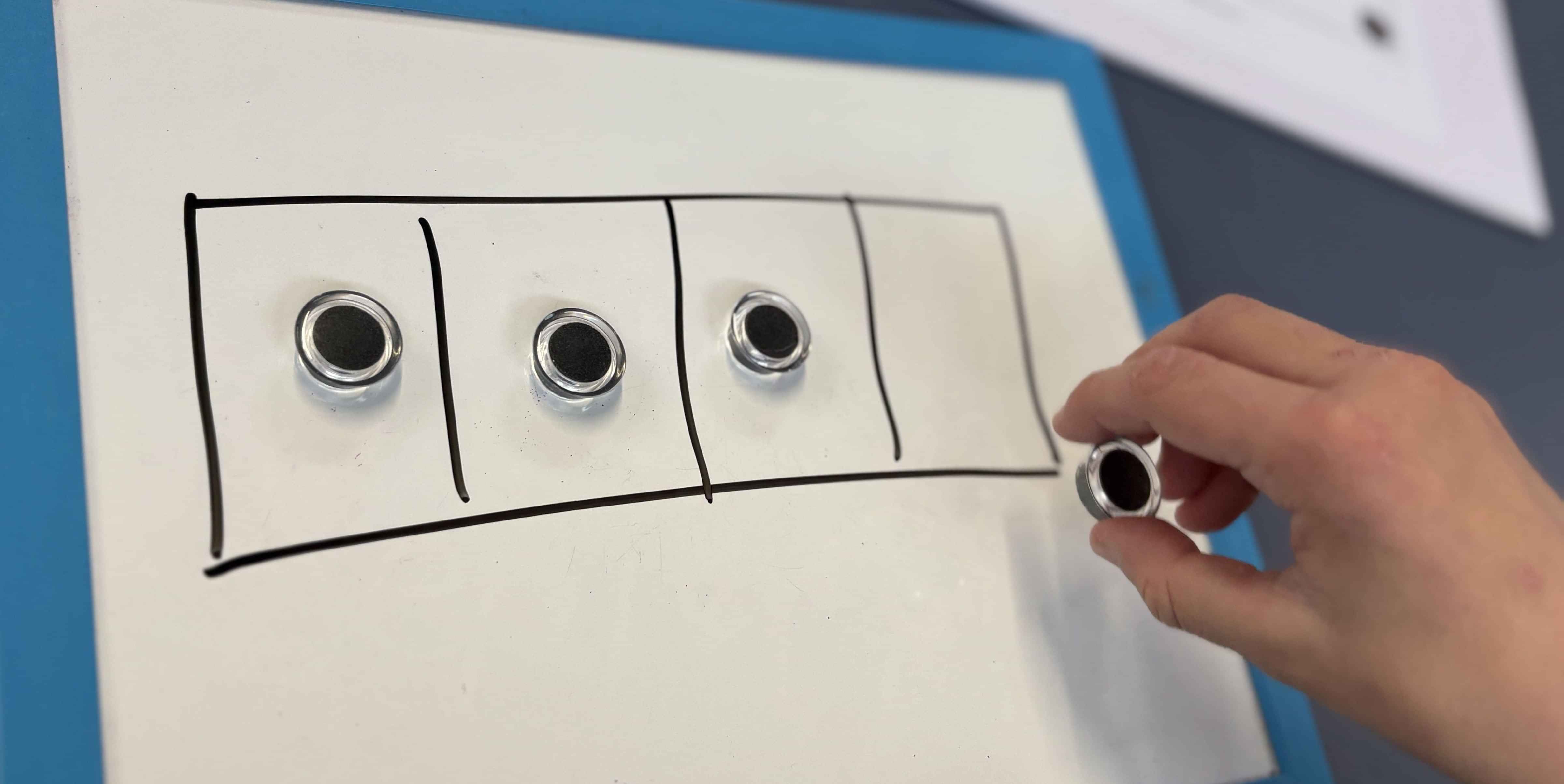
Retrieval in Action
Today’s review of open and closed syllables looked a little different. Instead of leading the review, Ange used it as a chance to check Hugo’s independent recall, inviting him to retrieve the concept himself.
At first, Hugo couldn’t remember. But with some guided prompts, he got there: “In open syllables the vowel says its name… closed syllables have a consonant blocking the vowel.” These moments are a reminder of how powerful retrieval-based practice is, and that cued recall can be just as effective when free recall isn’t yet within reach. This will now become a key part of lesson planning going forward.
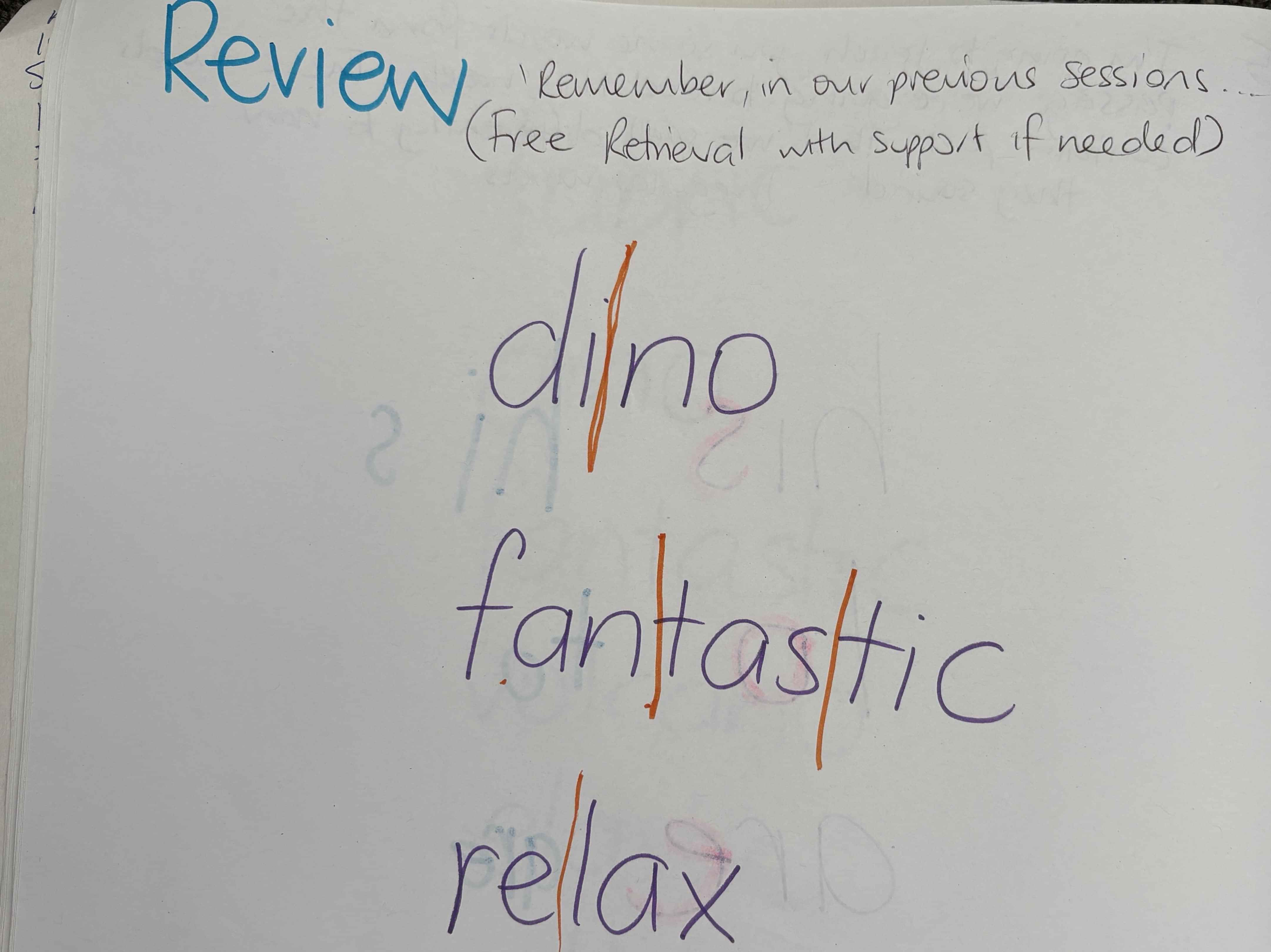
Introducing a New Planning Template
This session also marked a trial of a new two-session planning template designed specifically with school settings in mind.
The current iDeaL Approach for Specialists Phase 1 session plans are 60 minutes in length, which we have been adapting into two 30-minute sessions across the week. Initially, lessons were divided into two sessions, with half the content taught in each. The new structure instead breaks the lesson into two 30-minute blocks, ensuring that all elements of a Structured Literacy lesson are included consistently, with built-in review and decodable reading in every session.
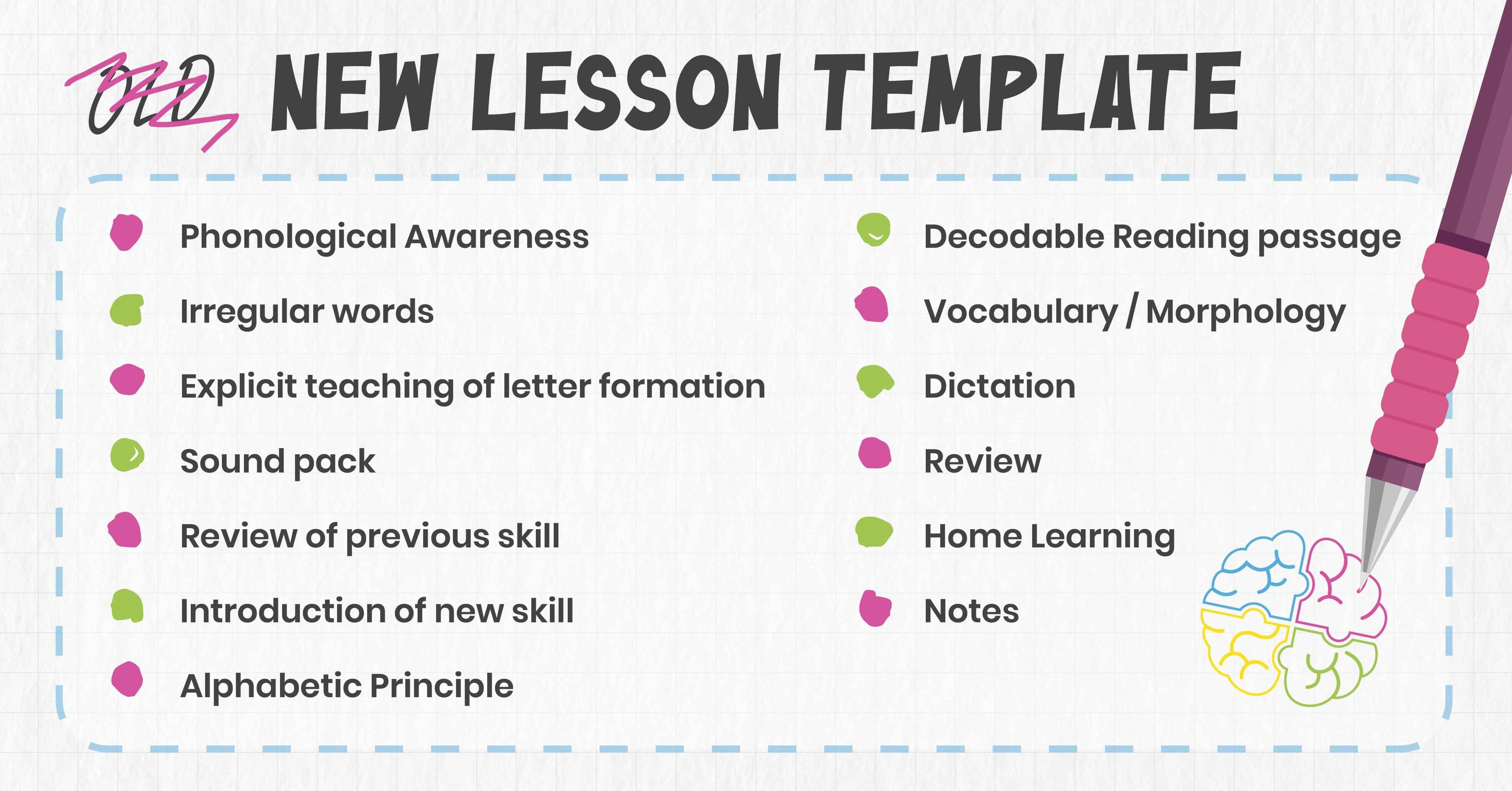
Key Features
Instruction aligns tightly with what Hugo has explicitly been taught — supporting mastery and avoiding cognitive overload.
Every session includes reading — progressing from small snippets to reading a full passage with comprehension questions in the second session. For students who would find this too challenging, the lesson could easily be stretched into three to ensure the passage is read as a whole.
Elements like morphology, letter formation, and irregular word review are evenly distributed for repetition and reinforcement.
The lesson design is adaptable for school use, offering specialists flexibility to choose what best fits their students’ needs. These templates will be available on the specialist platform soon — watch this space!
Looking Ahead
Although time was tight today, the structure held, and Ange is confident that, with familiarity, all components can be taught within a 30-minute lesson. We’re excited to see how this new format supports Hugo’s progress over time.
We’ll continue sharing Hugo’s journey because behind the planning templates and lesson structures is a student building confidence, skill, and a love of learning that grows stronger every week.
Confidence, Clarity and Continued Growth
Session 7
It was an amazing session. Hugo was engaged, focused, and moved through the lesson with momentum – even finishing with time to spare!
All lesson elements were completed, including phonological awareness, review, and decodable reading. For the handwriting component, the focus was only on letters a–m. This is still an area where Hugo is learning the process, so things were slowed down to give him more support.
To help with letter formation, Ange introduced a sky, grass, dirt handwriting template – with the letter models printed above. Previously, Hugo had been using a letter strip, but he was finding it tricky to keep his place while copying. The new layout helped provide clarity and kept him anchored during the task.

(This resource is currently being updated and will be available on the platform soon)
Session 8
This session served as a wrap-up for the week’s focus: reviewing open and closed syllables and explicitly teaching the /sh/ sound.
Knowledge of open and closed syllables are foundational for reading and spelling multisyllabic words – so they’ll continue to be a focus moving forward.
The lesson included a re-read of the decodable text, as well as spelling and reading multisyllabic words. One pattern Ange has noticed is Hugo’s tendency to add extra letters when spelling longer words. However, when he slows down and works syllable by syllable, his accuracy improves significantly. This is something that will continue to be built on.
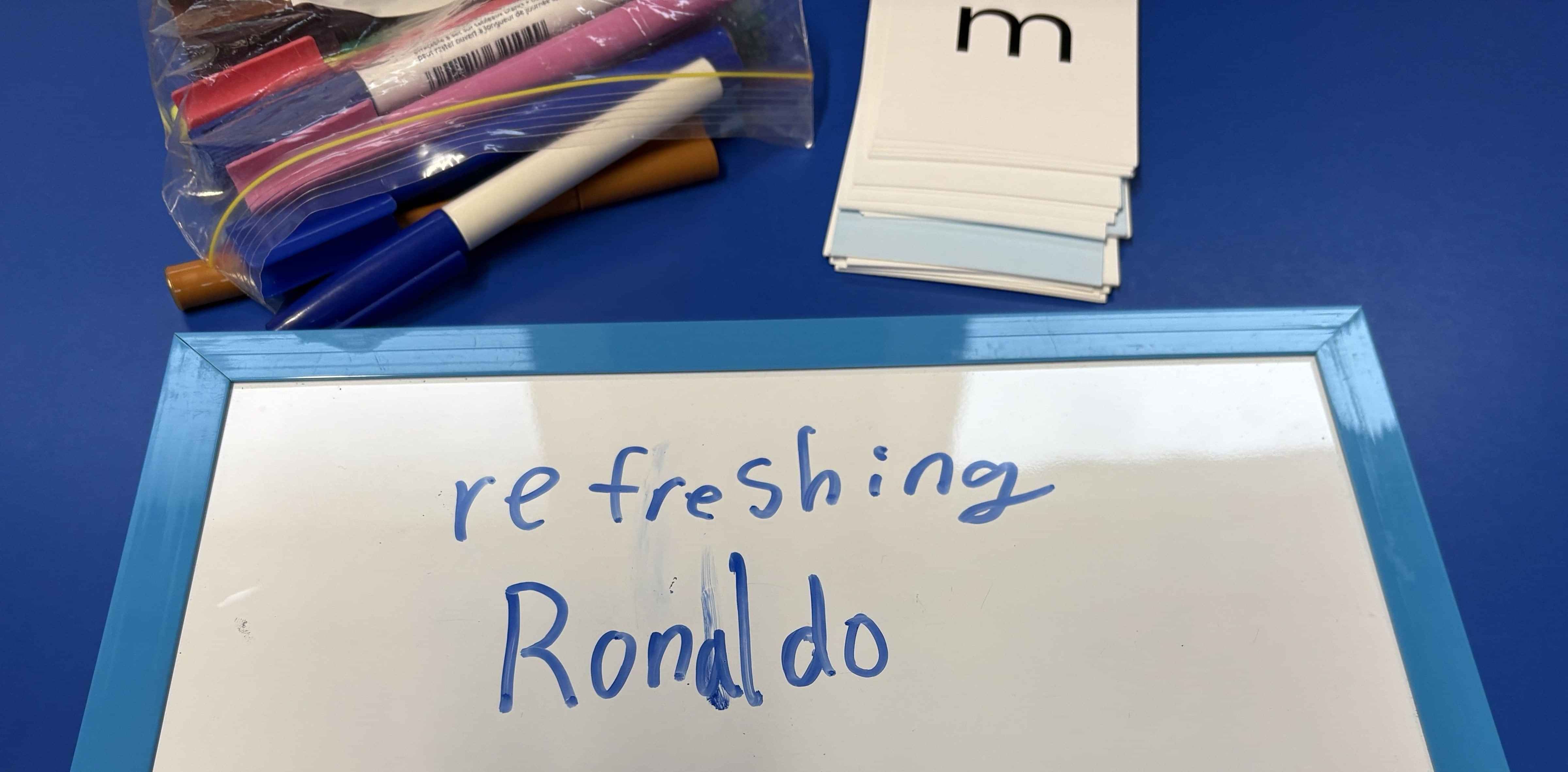
Whānau Feedback
It was lovely to receive feedback from Hugo’s whānau.
They shared that Hugo is genuinely enjoying the sessions and feels they’re helping him understand things more clearly. His positivity came through during their chat, which was great to hear.
He also expressed pride in his learning, even asking if his parent could come and watch a session sometime.
This kind of self-reflection and ownership is such a valuable part of the journey.
Looking Ahead
Hugo has made some good progress – especially in his confidence, motivation, and ability to apply concepts like syllable division and targeted sound knowledge.
The focus will remain on strengthening his ability to spell multisyllabic words, while also increasing opportunities for retrieval practice and review.
Confident, Focused, and Ready to Learn
Session 9
Planning the Next Concept
Choosing the next concept involves more than simply following the scope and sequence. The specialist platform’s sequence should always be personalised to ensure explicit instruction is provided where it’s needed most. Some concepts may already be mastered and only require review, while others need explicit teaching. A personalised scope and sequence for each student ensures instruction is both targeted and effective.
In Hugo’s case, the next concept in the Phase 1 scope and sequence was the /ch/ digraph. However, his assessment results showed that he had already mastered this concept, so we moved on to the next one: the two sounds of /th/. The /ch/ digraph will still be reviewed throughout this and subsequent lessons.
Ange has glued the student version of the Phase 1 scope and sequence into the front cover of Hugo’s workbook. This gives him a clear view of his progress and the concepts he has already secured — a simple but powerful visual of his personalised learning journey.
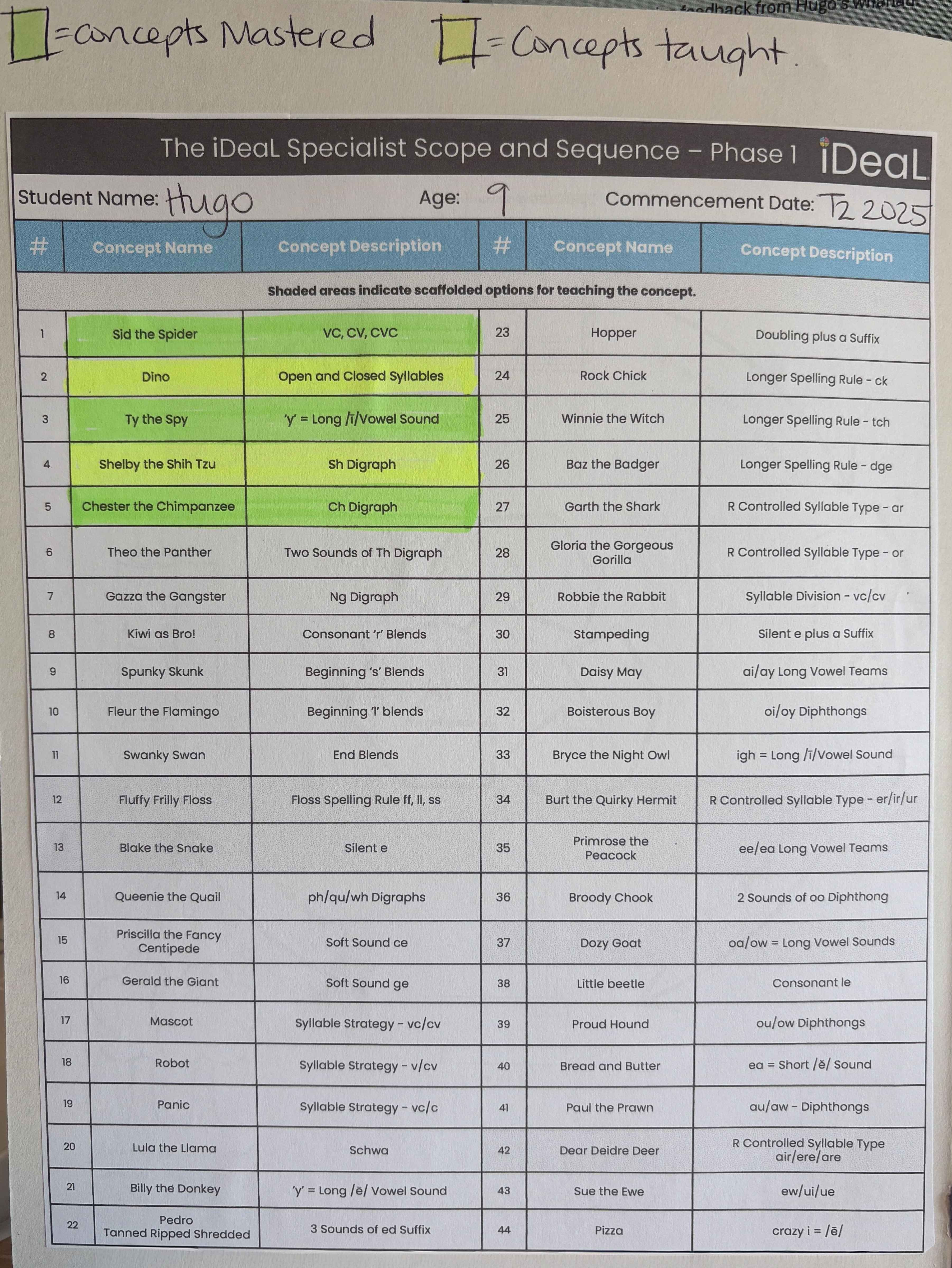
Choosing the Text
For this session, ‘Seth Had a Fall’ was selected as the decodable text. Although it included more irregular words than the other text for this concept, ‘Maths Was Fun’, it was the better fit for breaking the learning across two sessions. With explicit teaching of the irregular words, Hugo would be set up for success, even if extra review was needed due to the number of new words introduced.
Deciding how to split the passage into two sessions – and ensuring all concept words, irregular words, and other elements were explicitly taught before Hugo encountered them in the text – involved the following steps:
Highlighting concept words in pink: This made it easy to see where the words were introduced and how they were distributed throughout the passage.
Highlighting new irregular words in yellow: Some words identified as review words on the 60-minute plan were new for Hugo, as we had skipped the /ch/ concept.
Drawing a line to split the reading into two lessons: This ensured each section had a manageable number of words to teach explicitly.
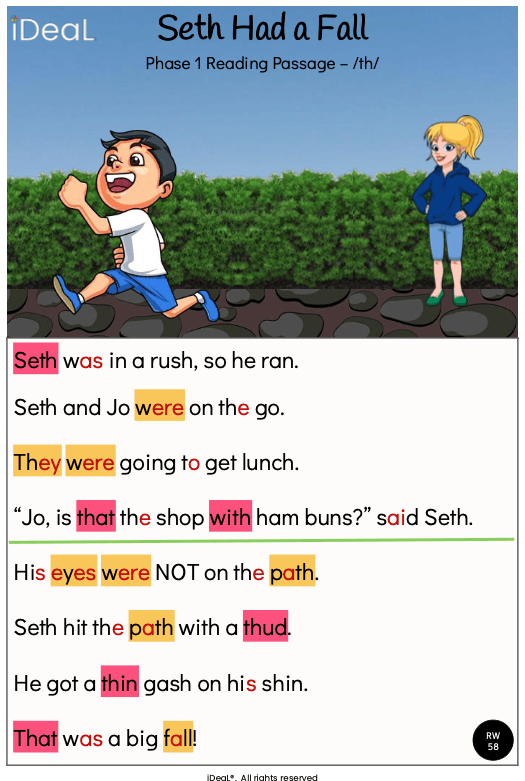
A Strong Start to the Term
When the session began, Hugo was on fire. He had practised his word-level fluency sheets over the holidays, re-read the /sh/ text, and even revised the night before. This preparation meant he came in confident, focused, and ready to learn.
The session was voice recorded to capture how long each element of the lesson took, helping refine planning and pacing using the new template.
Demonstrating Recall
The recording also captured Hugo’s ability to independently recall previously taught concepts. When prompted with the words ‘Hugo’ and ‘relax’, he confidently explained open and closed syllables.
For ‘Hugo’, he underlined the vowels and said, “This (‘Hu-’) is open because there’s nothing blocking the ‘u’, so the line goes straight down here. And this (‘-go’) is open too.”
For ‘relax’, he underlined the vowels, placed a syllable break after the ‘e’, and said, “re-.” He then explained that the two syllables were “open and closed.” When asked why the second syllable was closed, he replied, “There’s an ‘x’ blocking it.”
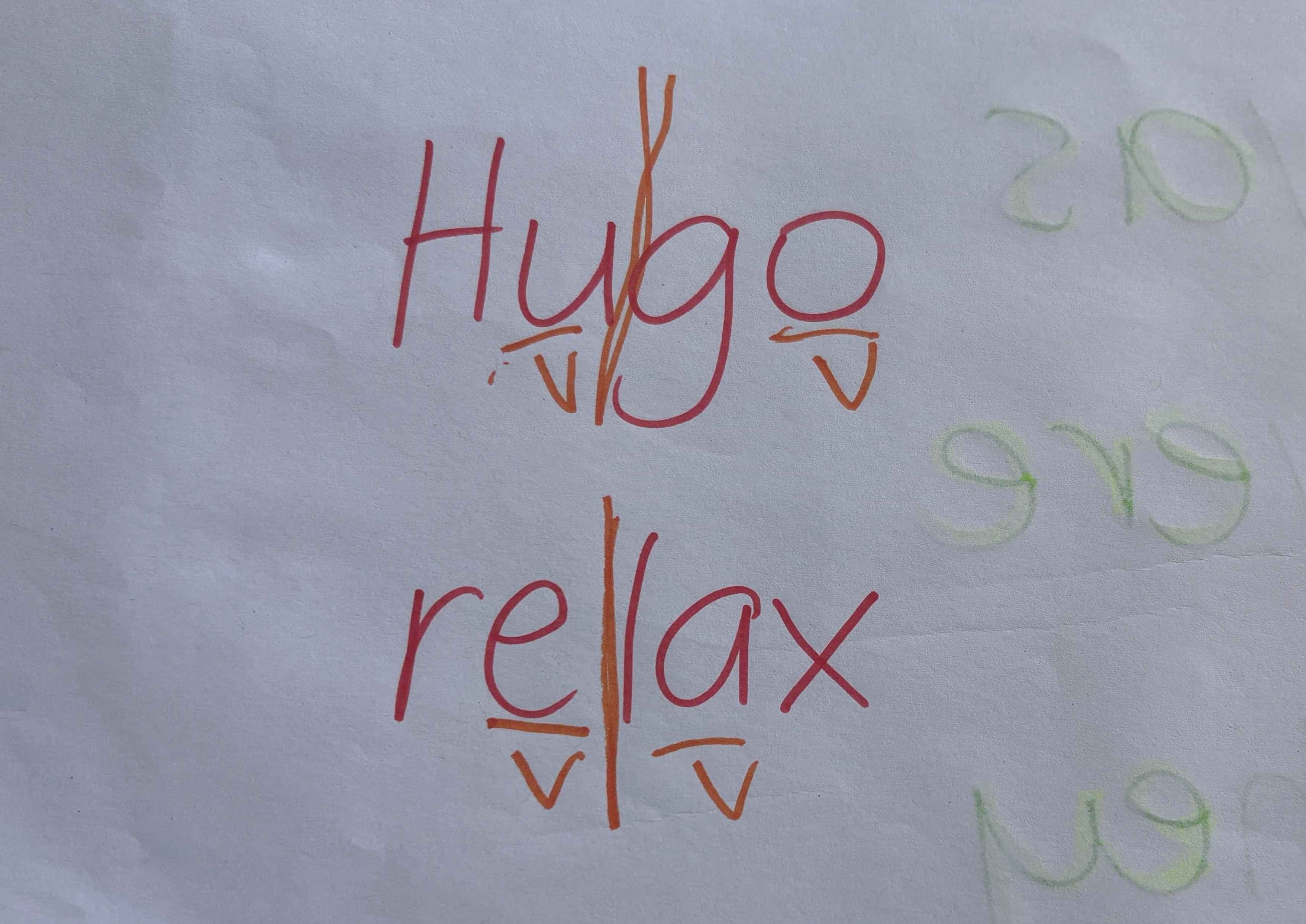
Asking Hugo to recall previous concepts with minimal prompting is a useful way to gauge how well he has understood and retained the explicit teaching. The more responsibility he takes for recalling prior learning, the greater the impact on his progress.
Established Routines
Hugo now knows the lesson structure inside out, which helps reduce cognitive load. He notices details such as when the wrong counters are used, or something hasn’t been highlighted correctly, and he’s quick to speak up. His sense of ownership is really shining through.
Another milestone: this was the first session where Hugo didn’t ask how much longer the lesson would be. Instead, he was surprised when the session wrapped up early, a real sign of engagement.
Looking Ahead
The focus will continue to be on consolidating the two sounds of /th/ through the selected text, reviewing the new irregular words, and providing opportunities for spaced review and retrieval.
With Hugo’s growing independence and well-established routines, the goal is to build his fluency, reinforce accuracy, and continue connecting new learning with what he has already mastered.
Home Learning & Parent Observation
Session 10
Home Learning Resources
We know that developing automaticity takes multiple, meaningful exposures, far more than what is possible in just two one-on-one sessions a week, even when paired with effective classroom instruction.
The home learning tasks on the specialist platform provide targeted opportunities for practice through concept word review, sentence-level reading and writing, and the ever-popular Roll and Read game.
Hugo has shown growing motivation to "beat his time" on the word-level fluency reading tasks. Before beginning each set, we draw attention to the focus concept, for example, all words containing the /sh/ sound. Words featuring previously taught concepts are left blank or shown in a different colour to reinforce prior learning. This repeated, purposeful practice is strengthening his word-level automaticity.
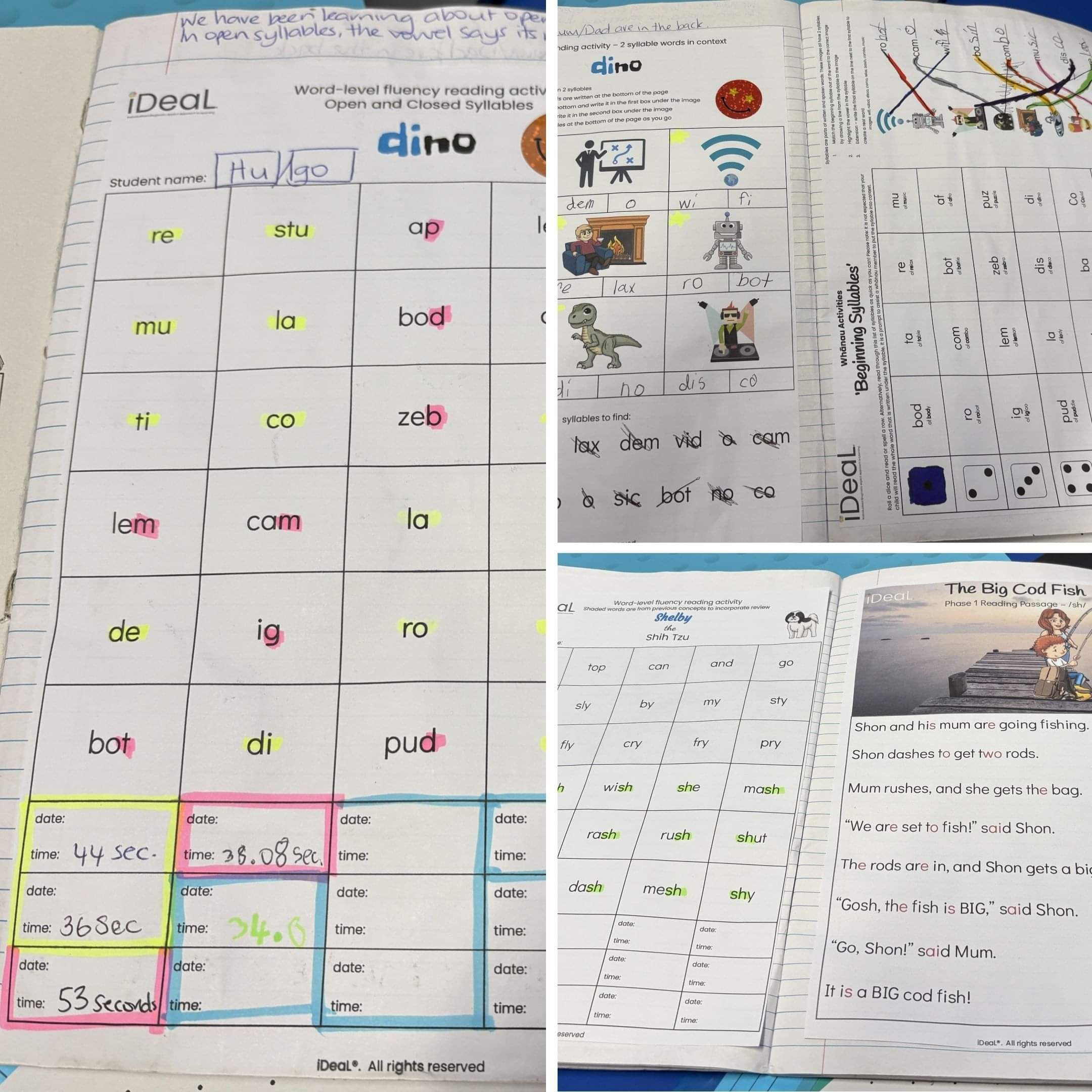
Session Reflection
Hugo is absolutely flying. Routines are well established, and we are working at pace through each lesson. Now that the structure is second nature, Ange is turning her attention to refining key elements of delivery. The plan is to revisit the modelled lesson for letter formation on the platform to ensure instruction is aligned and precise.
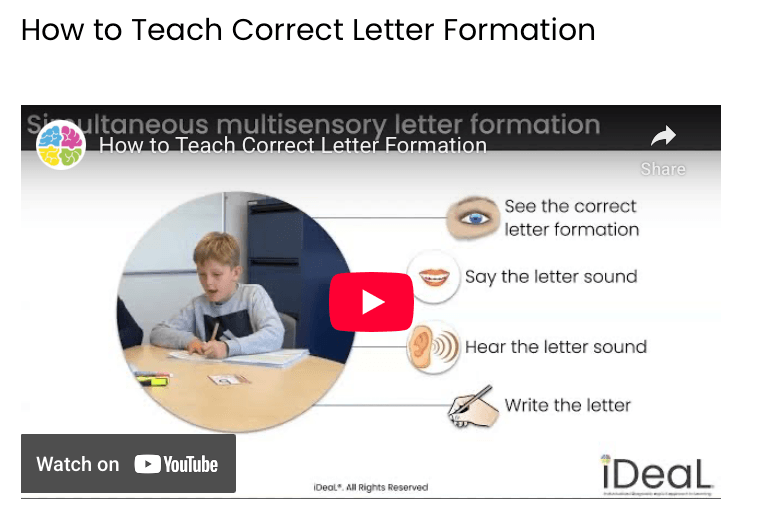
iDeaL Approach for Specialists users can access this resource in the iDeaL Instruction area.
Parent Observation
Hugo’s mum observed this session, and it was wonderful to see how proud Hugo was of his work. The smiles and quick glances her way said it all.
After the lesson, Ange spent some time with Hugo’s mum, who shared:
She was impressed by Hugo’s pace and productivity throughout the session.
His focus stood out.
At home, both parents have noticed a real shift in Hugo’s willingness to learn. He is now asking to read and is currently enjoying Diary of a Wimpy Kid, which is a huge milestone given he has never asked to read at home before.
This enthusiasm has even inspired his younger sibling to join in with bedtime reading.
During home learning, Hugo prefers to self-correct, asking his mum to simply point to a word he read incorrectly rather than give the answer. This is a wonderful sign of ownership and growth.
They have both noticed improvements in his ability and confidence, and Hugo himself has said he can feel the difference the sessions are making.
The family expressed deep appreciation for the opportunity and for the communication around Hugo’s learning. They can clearly see the positive impact of the intervention.
Hugo’s classroom teacher has also noticed clear gains in his reading. Recently, when asked to re-read a text from the Catch-Up Reader series that he had previously completed, he expected he would manage only a few chapters. Instead, Hugo read the entire book from cover to cover with minimal errors, demonstrating both fluency and confidence.
Next Steps
Moving forward, Ange will continue to refine the delivery of the lessons, ensuring each element in taught explicitly and for the greatest impact. The next focus area will be phonological awareness to ensure that these vital foundation skills are being taught effectively.
For Hugo, the focus will be on trying to maintain this great momentum, enthusiasm and focus.
Building Phoneme–Grapheme Understanding
Session 11
Recently, Ange has been reflecting on phonological and phonemic awareness — and particularly on when to introduce print with these tasks for Hugo. This thinking is timely for two reasons: she has been developing and trialing the new phonological awareness resources just released on the iDeaL Approach for Specialists platform, and she remains mindful of maximising instructional impact within each session. The goal is always to teach explicitly so that Hugo can make the crucial connections between sounds and print that underpin fluent reading and spelling.
Rhyme Identification and Generation
Hugo continues to demonstrate strong skills in identifying rhyme when given choices (for example, “Say planet. What rhymes with planet — patient or granite?”). Generating his own rhymes, however, remains more of a challenge. When asked to think of a word that rhymes with bed, he initially suggested words beginning with b rather than sharing the same rime. After modelling that red rhymes, his next attempt was running. With support, Hugo was able to come up with a couple more words – head and said.
Next session, Ange plans to place greater focus on rhyme generation, introducing visual prompts such as an alphabet strip to support Hugo in identifying potential rhyming words more effectively.
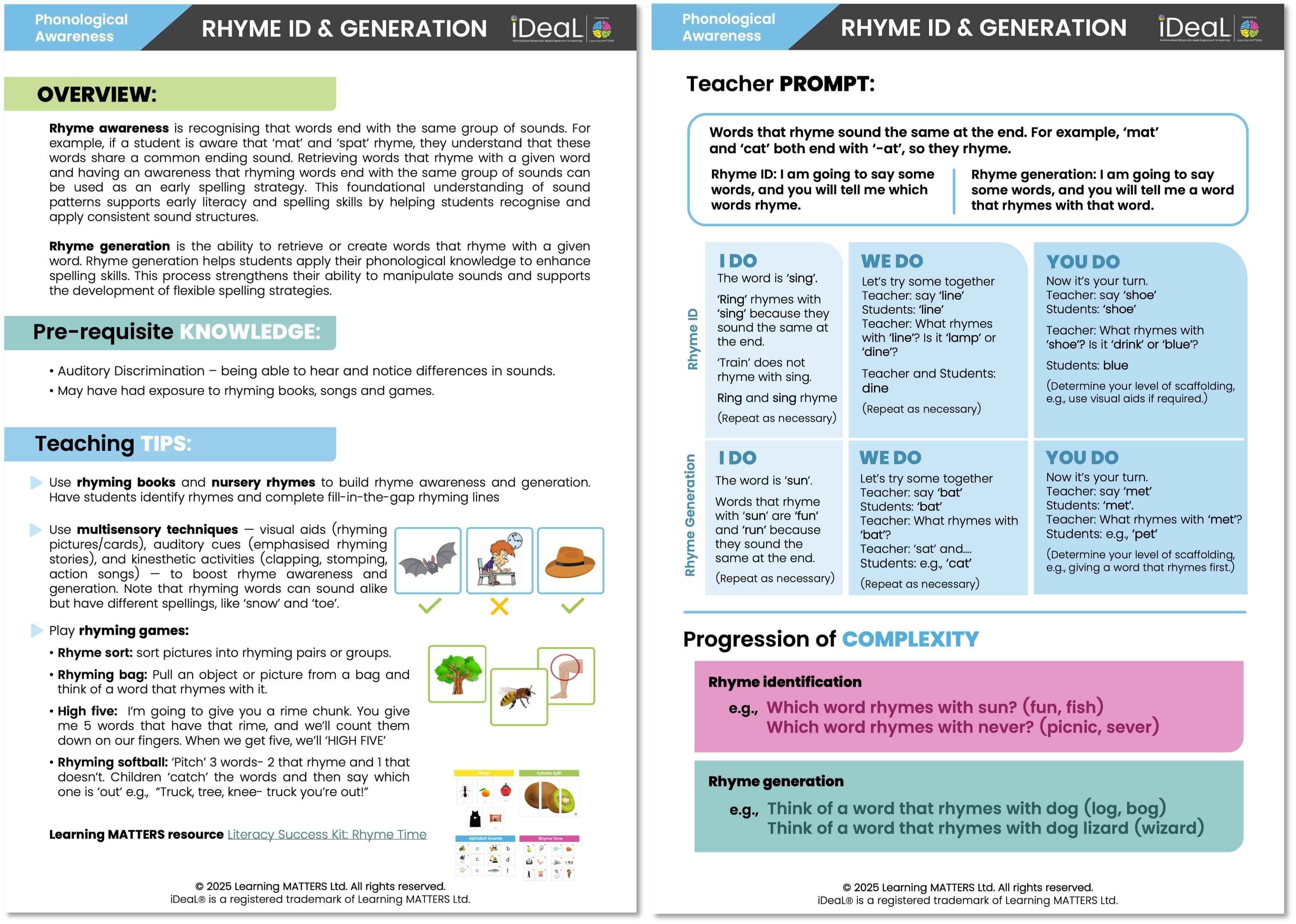
Phonological awareness tasks play an essential role in helping students grasp the alphabetic principle — that letters represent sounds in spoken language. The new resources on the platform have been invaluable in planning these activities, providing clear wordlists and teacher prompts to support explicit instruction.
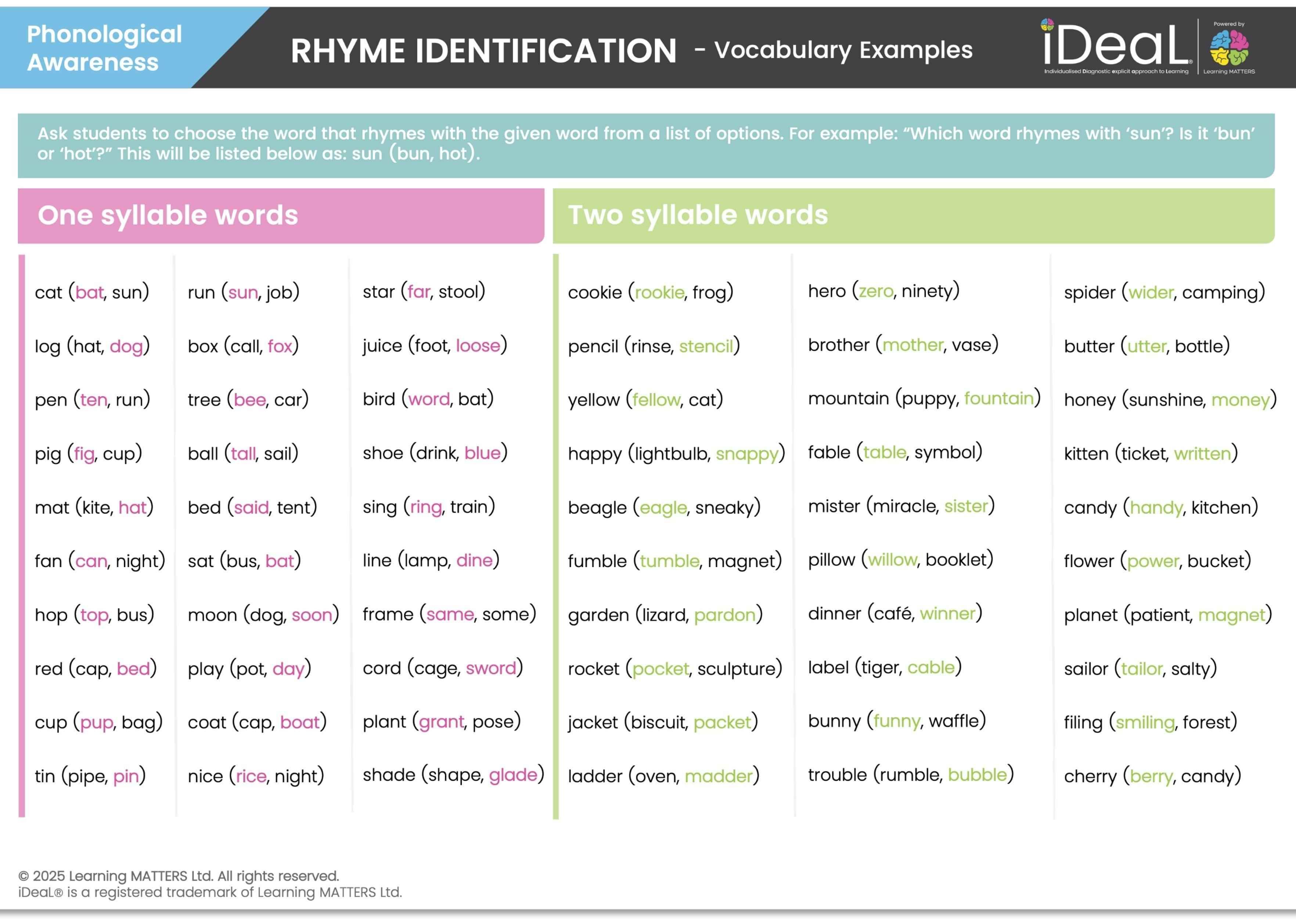
Phoneme Manipulation
Over several sessions, Hugo has been working on tasks involving the deletion and substitution of the initial phoneme in a blend. Today, he successfully manipulated the initial phoneme in a four-sound word:
“Say flock. Now say flock, but change the /f/ to /c/.”
He confidently responded, clock.
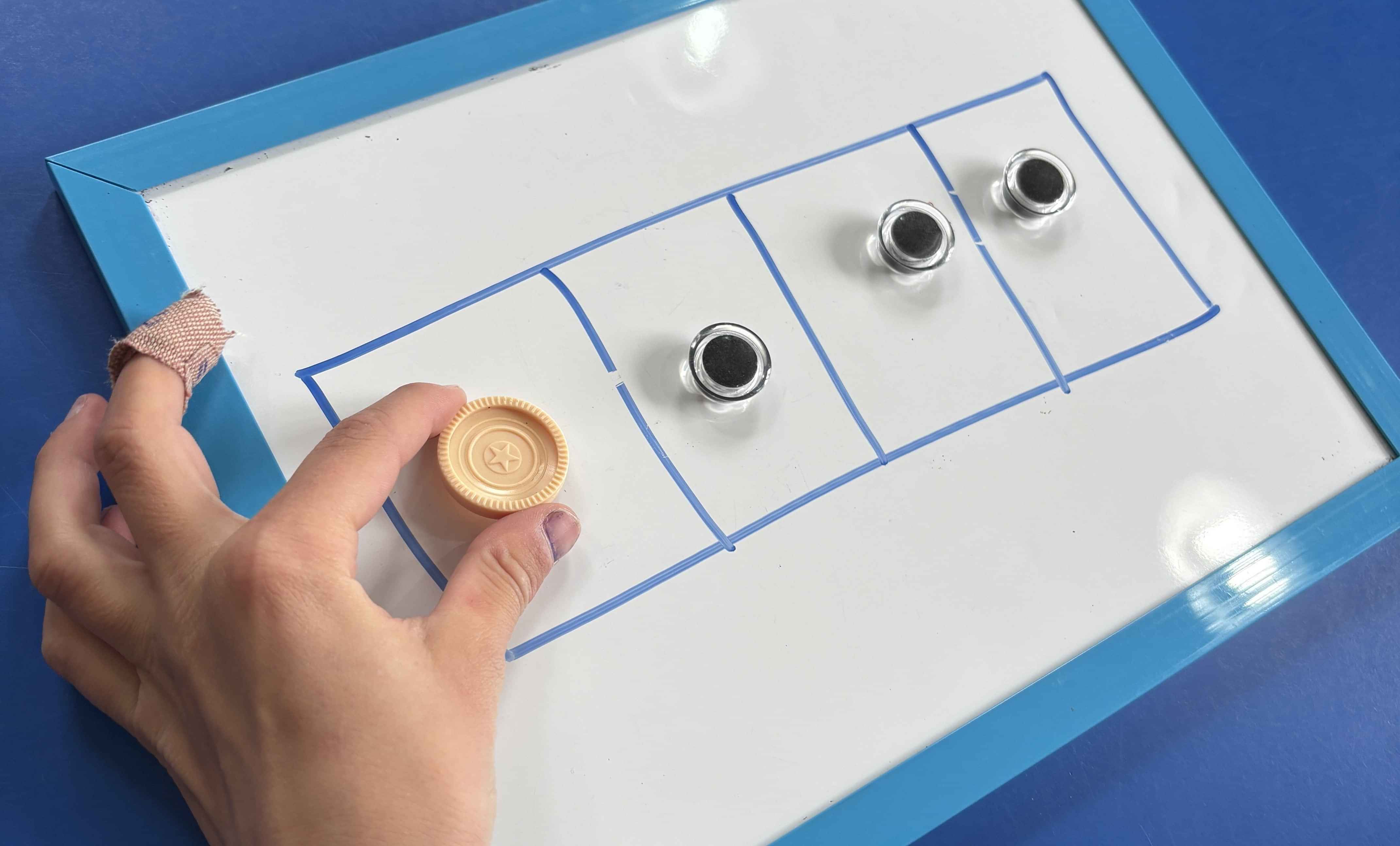
Some confusion arose in other parts of the lesson, particularly with short vowel sounds — Hugo occasionally mixed up short /a/ and /u/. He also sometimes relied on letter names rather than sounds when spelling. These will remain a focus, as unlearning such habits can take time and deliberate practice.
Next Steps
Next session, Ange will begin introducing the letters that represent the sounds, further strengthening Hugo’s phoneme–grapheme connections — a vital step in transferring these developing oral skills into reading and spelling.
Connecting Sound to Print
Session 12
Today’s session went smoothly, and Hugo was highly motivated throughout.
The phonological awareness tasks showed an interesting pattern. Hugo can confidently identify rhyming words orally (for example, “Say log. What rhymes with log – hat or dog?”), but this understanding becomes less secure once letters are introduced. This suggests that the connection between sound and print in the context of rhyme may not yet be fully established for him.
Because many rhyming words are spelled with different graphemes representing the same sound, Ange has been reflecting on how best to introduce print during rhyme work. For example, when she asked Hugo which words rhyme with case, she wrote the word on the whiteboard. They then used an alphabet strip to help Hugo generate rhyming words, and Ange supported him by writing initial letters as cues. With support, he was able to identify base, face, and lace – a great moment of success and persistence.
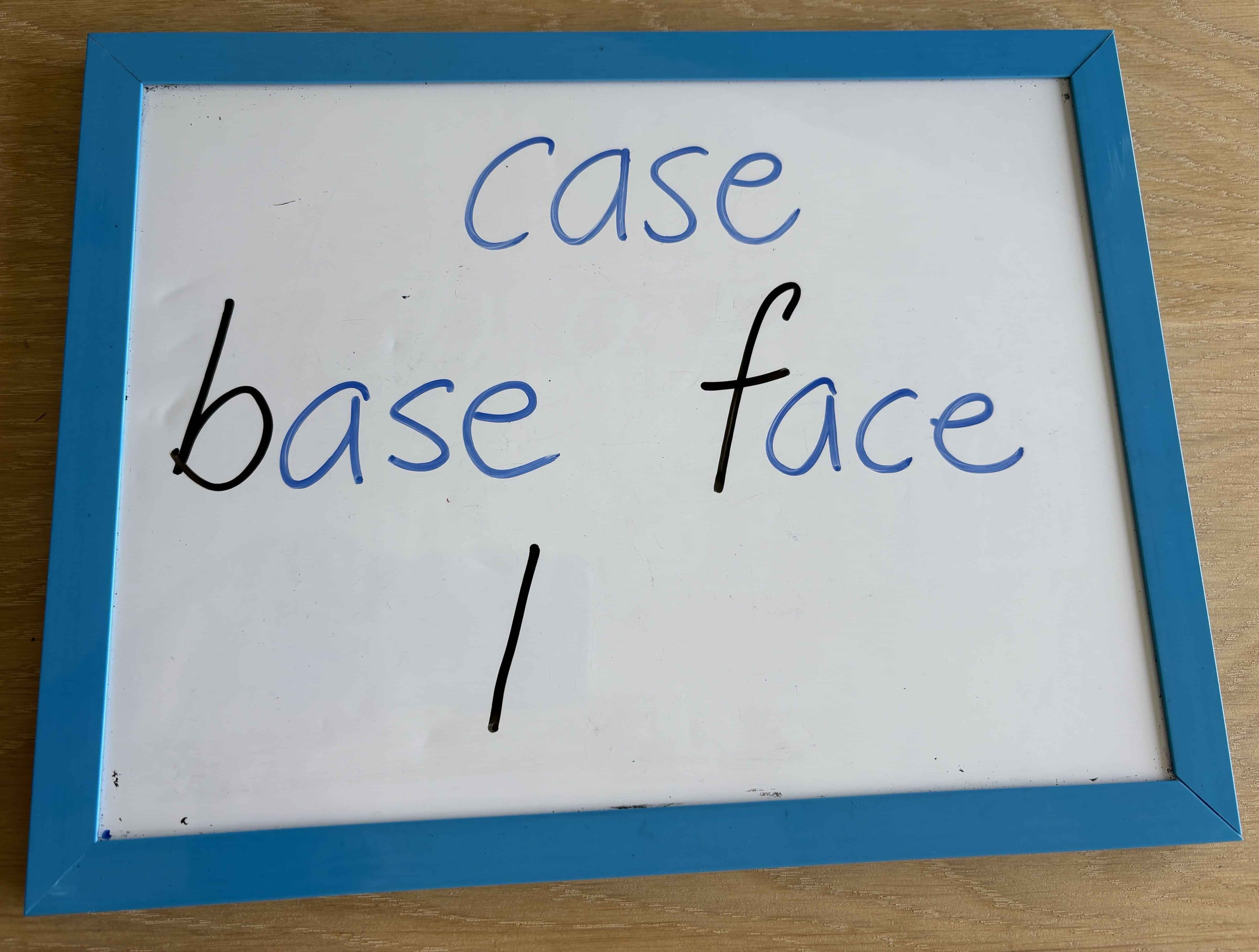
Hugo also worked on phoneme manipulation, completing initial phoneme deletion tasks such as “Say stop without /s/ = top.” They began with Elkonin boxes and counters, then linked the activity to print by showing what the new word looked like. This explicit connection helps students understand how the sounds they hear are represented in writing – a key step toward fluent decoding and accurate spelling. Ange noticed several ‘lightbulb’ moments today as Hugo paid close attention to the letters that represented the sounds in the words.
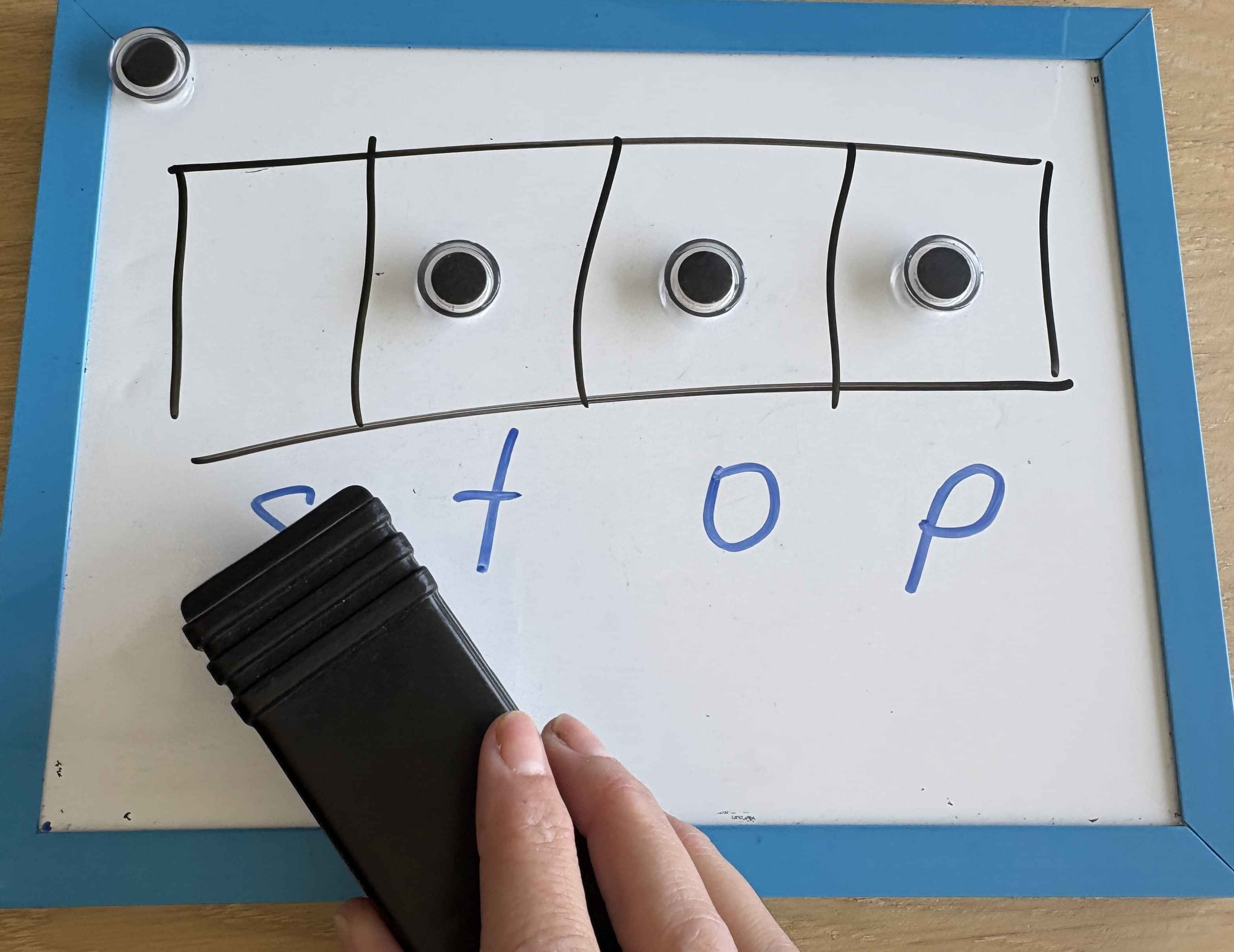
These activities continue to strengthen the bridge between phonemic awareness and orthographic knowledge, supporting Hugo to connect what he hears with what he sees and writes.
Phonemic Awareness and Print
While oral phonemic awareness instruction is valuable, research shows that its impact is significantly enhanced when paired with print. The National Reading Panel (2000) found that “when phonemic awareness instruction is supported with letters or visual cues, children are better able to understand the relationship between sounds and print, making the instruction more effective and transferable to reading and spelling tasks.”
This link between sound and symbol is also reinforced by Ehri (2005), who highlighted that “grapheme–phoneme connections help children remember how to read and spell words,” and by Kilpatrick (2015), who explained that incorporating print fosters orthographic mapping – the process that enables words to become permanently stored in long-term memory.

For Hugo, bringing print into phonological awareness instruction will strengthen these critical connections and support his growing confidence as a reader.
At the end of the session, Ange asked Hugo if he had noticed any changes in his reading. He shared that reading feels easier now – “I can read more words.” His mum has also noticed improvements at home. Hugo remains motivated to read, continuing with Diary of a Wimpy Kid, and he takes pride in his home word-reading practice, aiming to “beat his time” each day.
Next Steps
Continue reinforcing rhyme generation and phoneme manipulation tasks, pairing oral work with print to strengthen sound–symbol connections.
Strengthening Hugo’s ability to identify the short /a/ and /u/ sounds, and encourage him to say the sounds as he writes rather than the letter names.
The Power of Review and Retrieval
Session 13
For this session, Ange decided it was the perfect time to pause and review everything Hugo has learned so far rather than introducing something new. Intentional review is a key part of explicit instruction as it helps check what can be retrieved from long-term memory, supports transfer of learning, and ensures knowledge is truly embedded over time.
What the session involved
Irregular words: Hugo decoded and encoded all 15 irregular words taught so far. Ange initially suggested just a few to write, but Hugo was determined to write them all, a clear sign of his growing confidence and motivation.
Teach the teacher: Ange handed over the reins and invited Hugo to become the teacher for a moment, explaining key concepts such as open and closed syllables, /sh/, the two sounds of /th/, and /ng/. This free recall task asked Hugo to retrieve information without prompts, one of the most effective ways to strengthen and solidify learning.
Hugo approached the activity with enthusiasm, proudly sharing what he knew. He was accurate with most of his explanations, though he did mix up the /ng/ digraph with the suffix -ing, so this will be revisited in the next session.
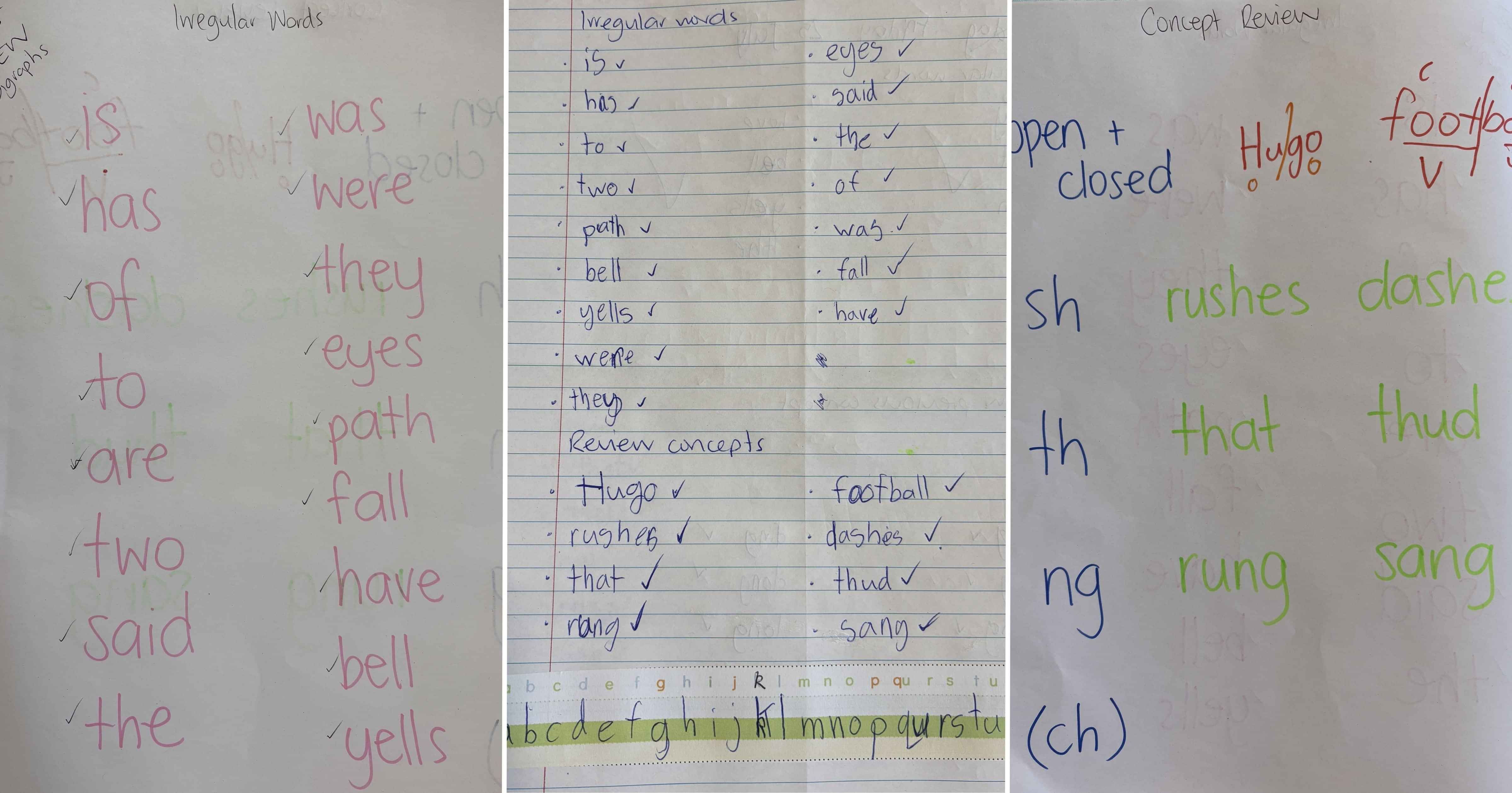
Alongside these review activities, Ange kept the familiar structure in place with phonological awareness, sound pack work, and letter formation tasks to maintain consistency and routine.
Why review matters
Research shows that retrieval practice, or free recall, is one of the most powerful ways to make learning stick. Within explicit instruction, this connects to the principle of judicious practice, which is about finding the right balance between new learning and review. Regular review strengthens memory and understanding, helping students confidently access and apply what they have learned long after initial teaching.
Feedback from Hugo’s teacher
Hugo’s classroom teacher has noticed a real boost in his confidence, and his progress continues to build. His latest writing sample was much more detailed than at the start of the year, a clear reflection of the growing connections between his speech, sound, and print knowledge. It is wonderful to see his learning
Next Steps
Looking ahead in Hugo’s journey, the next focus in the scope and sequence is building his knowledge of blends. Our next concept will be beginning ‘s’ blends, giving Hugo the opportunity to strengthen his decoding and encoding skills as he continues to build on the solid foundation established so far.
Blends and Comprehension
Session 14
Today’s lesson was observed by a teacher from Hugo’s school. It was great to have their interest and support in the work we are doing.
Beginning s blends were challenging for Hugo today. Some of the combinations were difficult for him to articulate, and he became a little muddled at times. We needed more repetition than usual to help him secure success. Despite the difficulty, he stayed positive and kept trying, which is always worth celebrating.
Session 15
Time and space between sessions can make such a difference. Today, Hugo read and spelt the concept words with confidence, and we moved through the lesson quickly.
A key improvement Ange has noticed since Hugo’s initial assessment is his growing ability to attend to all the sounds in a word, both at word and sentence level. Earlier in the year he was doing quite a bit of guessing, so this is a meaningful shift in his reading behaviour.
When reading the Phase 1 passage, Hugo now approaches the text with confidence. He trusts that the words will be accessible for him, and this predictability helps him read more accurately. One of the benefits of the Phase 1 passages is that they are controlled and cumulative, which means there are no surprises and no words outside the student’s scope and sequence.
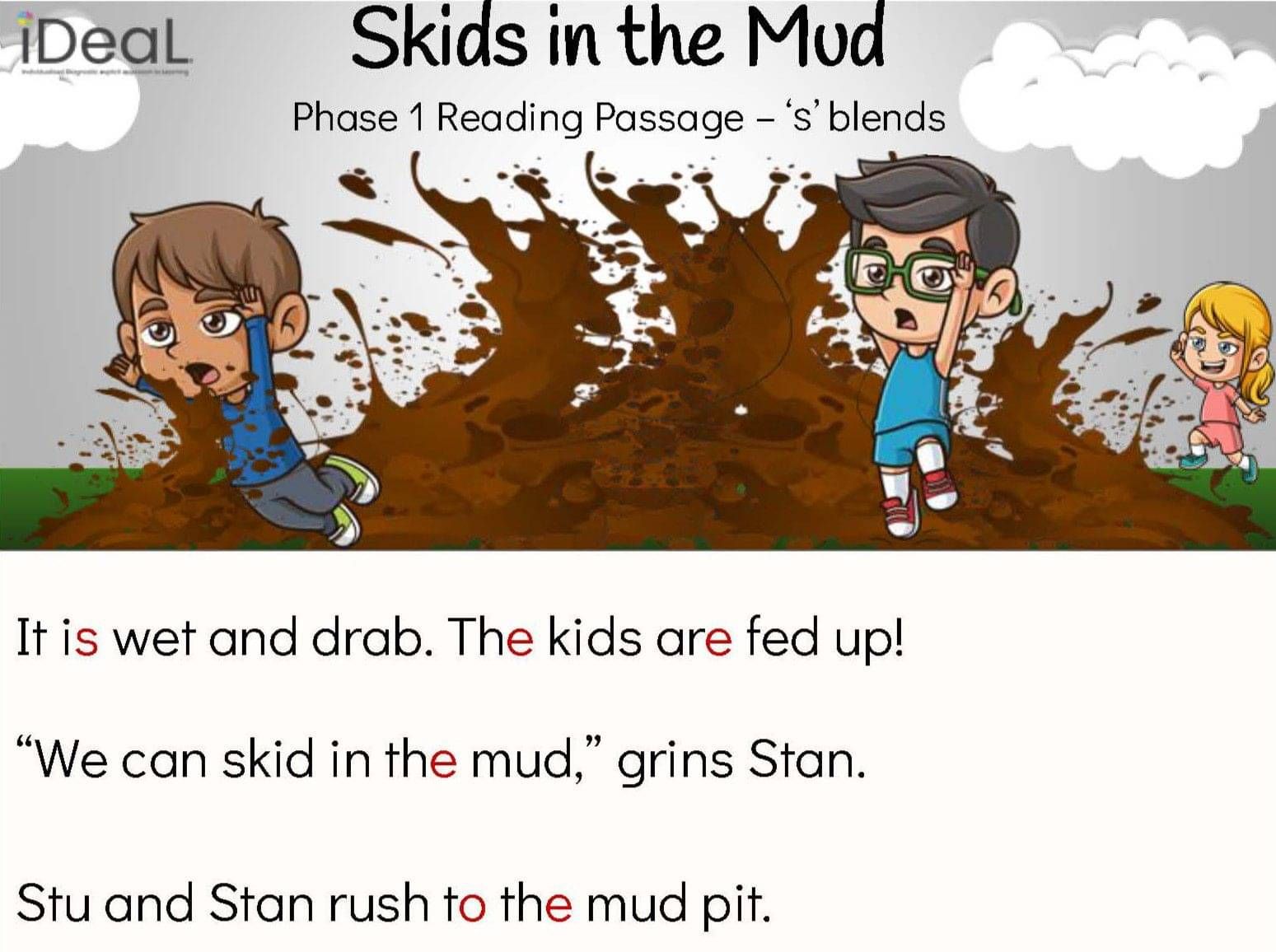
While these gains are significant, there is still more work needed before we see consistent transference to authentic texts. In the classroom Hugo encounters text that often includes concepts he has not yet been explicitly taught. The cognitive load is high, and this is when old habits like guessing or relying on the initial sound can slip back in. However, we know the intervention is working. We will continue to strengthen his knowledge and build fluency and accuracy so that this progress becomes more automatic in all reading contexts.
Session 16
Today’s sound work highlighted how quickly Hugo has learned to pronounce blends correctly. At the beginning, he tended to articulate each phoneme separately, such as saying /s/ then /w/ for sw, or adding an extra “uh” sound to the end of blends like bl. Accurate articulation is essential to support a student’s ability to blend sounds to accurately read and spell words.
Ange has also noticed that Hugo often finds it difficult to retell or answer comprehension questions about the text. This is understandable. Once reading becomes easier, the desire to read faster is strong. His increased confidence and ability to lift words off the page is something to celebrate, but we also know that comprehension is central to reading success. This will be an ongoing focus.
To support this, Ange has printed the comprehension questions for each text and added them alongside the passages in Hugo’s home learning book. This will make it easier for Hugo and a parent to talk about what he has read, helping him practise retrieving information and deepening his understanding.

Next Steps
Over the next couple of sessions Ange will reassess Hugo using the Literacy Learning Update. She is looking forward to seeing the progress he has made and identifying the next areas of focus as they continue their work together.
Re-Assessment
Session 17
After several weeks of steady work and visible gains, Ange began this session by assessing Hugo using parts of the Literacy Learning Update Assessment. This provided an opportunity to check in on how his foundational skills are developing and to identify areas that will guide the next steps in his learning. They completed the following.
Phonological Awareness
Hugo showed a marked improvement in his ability to identify and generate rhyme. His phoneme manipulation skills also improved, and he managed these tasks well until he needed to manipulate medial sounds. This is understandable, as he has not yet received teaching in this area.

Decoding Sounds in Isolation
Hugo was more confident and accurate when reading digraphs, which is encouraging, as these concepts have been recently taught. He was also able to read all triple blends. This demonstrates his ability to transfer his understanding of s-blends into triple blends, for example ‘st’ to ‘str’, ‘sp’ to ‘spr’, and ‘sc’ to ‘scr’. This was exciting to observe.

Session 18
Decoding Non-Word Syllable Types and Spelling Rules
Hugo is increasingly able to transfer his sound knowledge into reading, as seen in his decoding of a growing number of non-words. Non-words allow us to assess his understanding of sounds rather than his recall of familiar words. Since the last assessment, Hugo has made progress across all areas, with notable gains in reading open syllables and triple blends.

Phase 1 Spelling
Hugo has shown improvement in his Phase 1 spelling. He is more confident when sounding out words, including multisyllabic ones, although he sometimes inserts extra letters without considering how these affect the word. We will continue to support his understanding of the short /a/ and /u/ sounds, which he occasionally confuses. Regular breaks were taken during the assessment, about every ten words, and this appeared to support his performance.

iRSR
Hugo read a number of high frequency words correctly. He was initially very focused on reading at pace, which reduced his accuracy. On a second attempt, he was able to self-correct ten errors. He was not yet able to retell the story or answer comprehension questions.
Writing Sample
The school had recently completed a writing sample, so this was used to compare with Hugo’s writing from the beginning of the year.
Hugo wrote more words than in his February sample. He correctly spelled several high frequency and irregular words such as ‘I’, ‘and’, ‘it’, and ‘then’. He also spelt ‘over’ and ‘yelling’ correctly and made strong phonetic attempts with other words, such as ‘diger’ for digger and ‘skremd’ for screamed.

Reflection on the journey to date
For Ange, this journey has become a powerful demonstration of how responsive, evidence-based literacy intervention can work not only in a private-tutor setting, but also in a school one.
Through the thoughtful adaptation of the lesson structure from 50-60minutes to two shorter 30-minute sessions, embedding frequent review and retrieval, and remaining attentive to what works for Hugo, Ange has witnessed significant shifts: not only in Hugo’s decoding and spelling skills, but in his confidence, engagement, and sense of pride in his learning. These changes matter.
At the same time, as seen in sessions like Session 6, his progress hasn’t always followed a straight, predictable path. Breaks in routine triggered regression, misunderstandings re-emerged, and skills sometimes slipped. However, this just reaffirms that intervention needs time, consistency, and deliberate repetition. Embedding review and building routines aren’t just extras; they are essential.
Above all, this journey to date has reaffirmed what we already know: confidence, trust and relationships matter. When the student, teacher, specialist, and whānau come together around a shared goal, that’s when real growth happens. For Ange, seeing that happening is one of the most rewarding outcomes of this intervention.
What's in store for 2026?
As we move into 2026, we look forward to sharing more of Hugo’s progress, including insights from his parents and from Hugo himself as he begins to recognise his own successes. We will also include a short video snapshot from a lesson to show what this learning looks like in action. Ange will continue working alongside Hugo and will provide updates as his journey continues.



